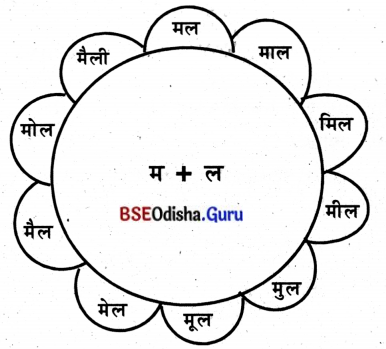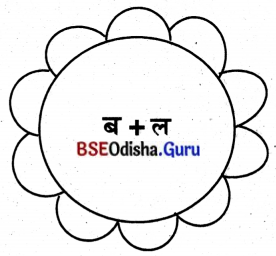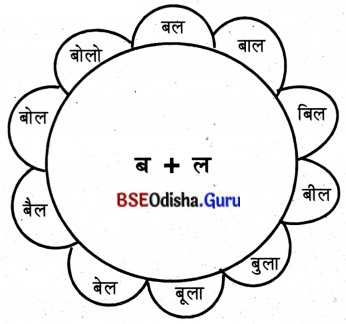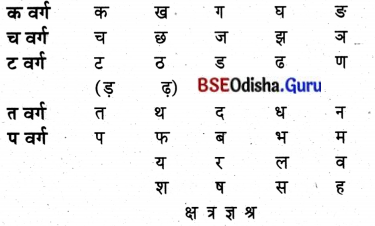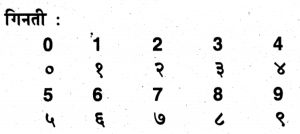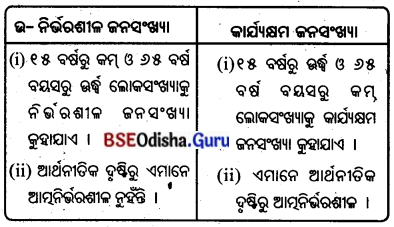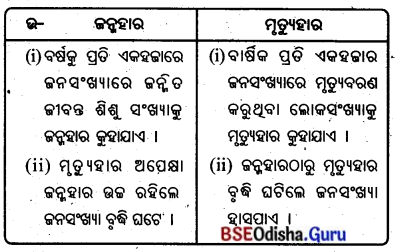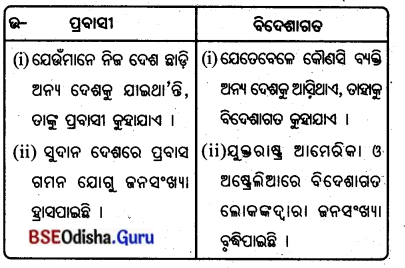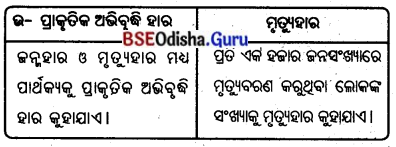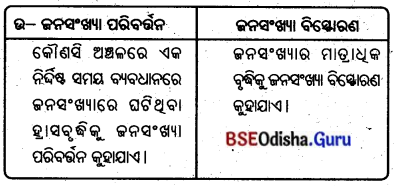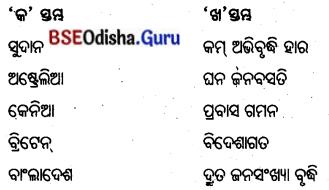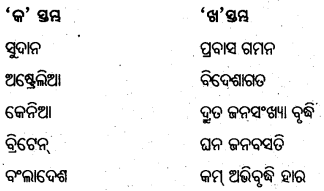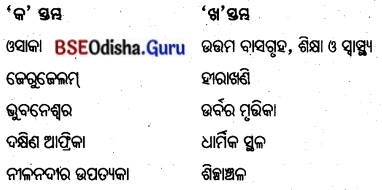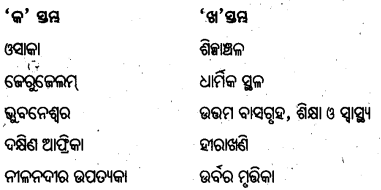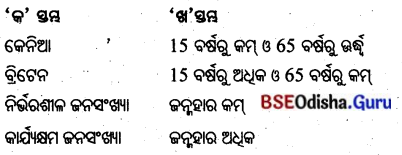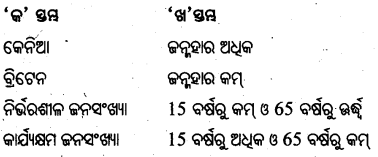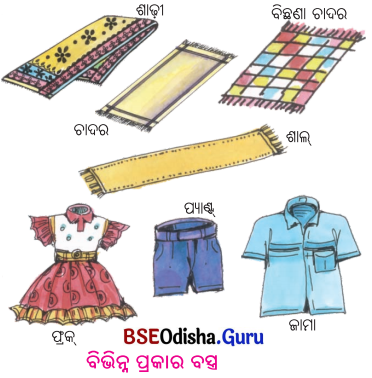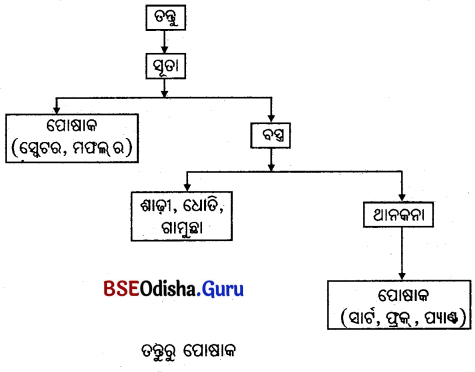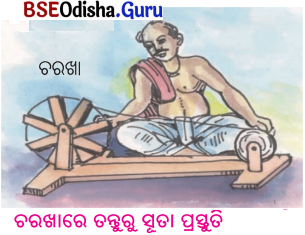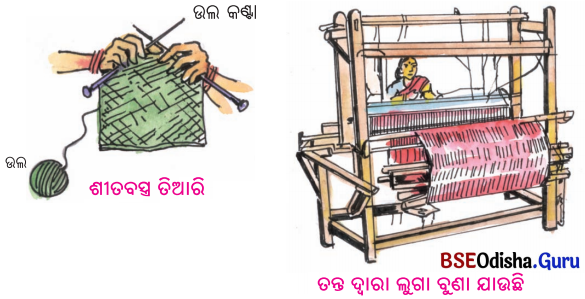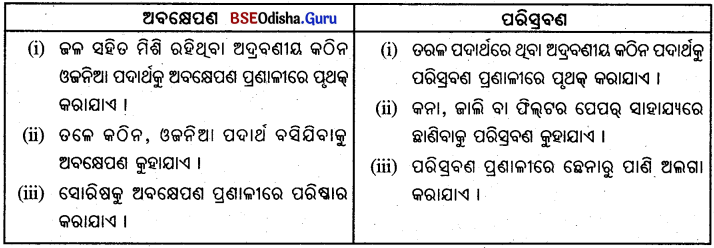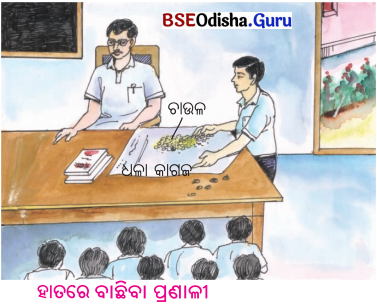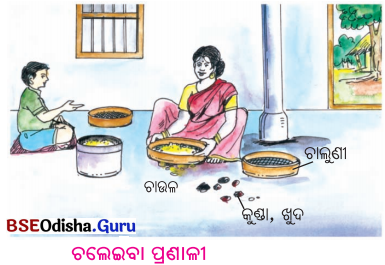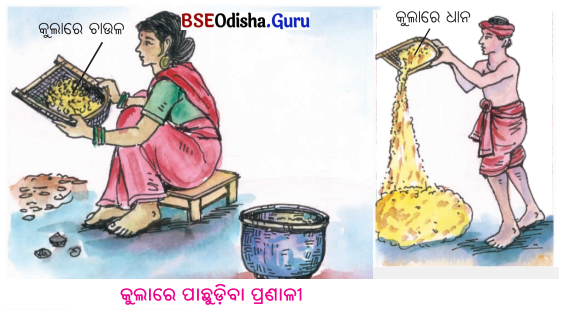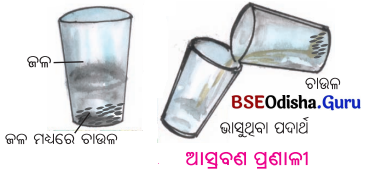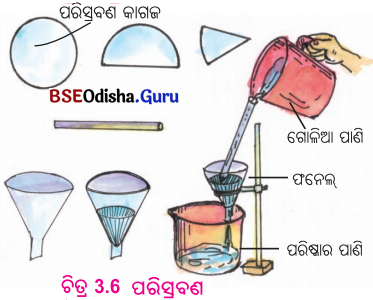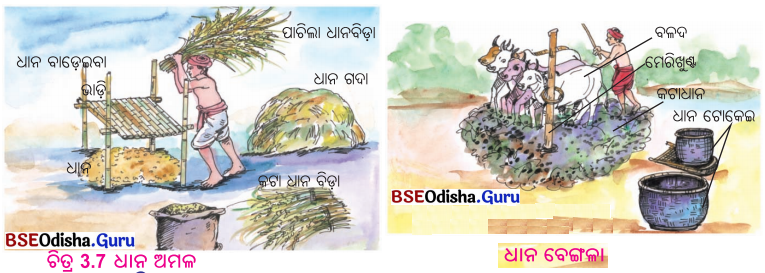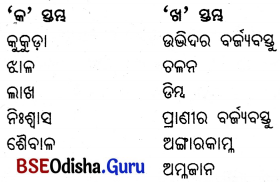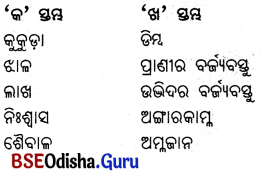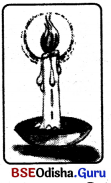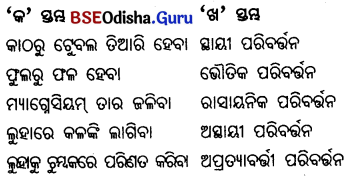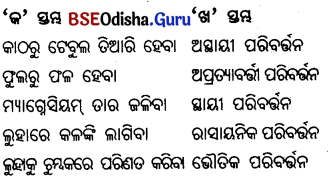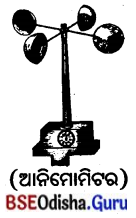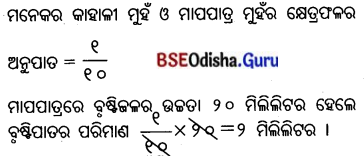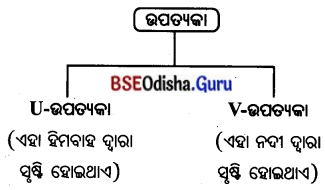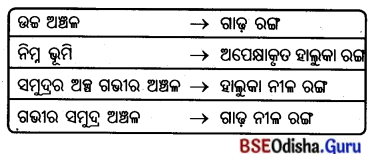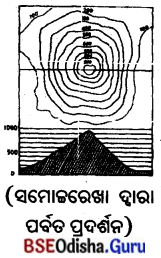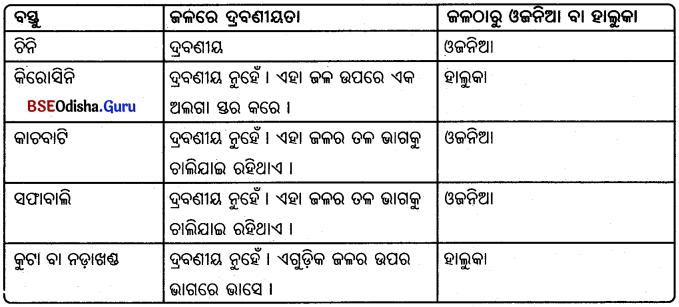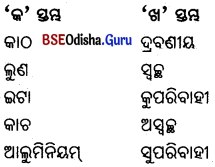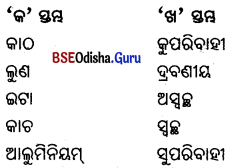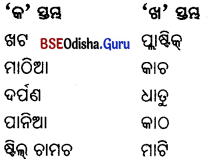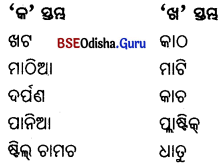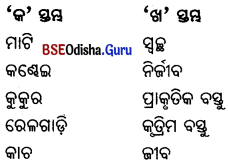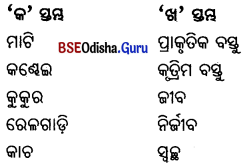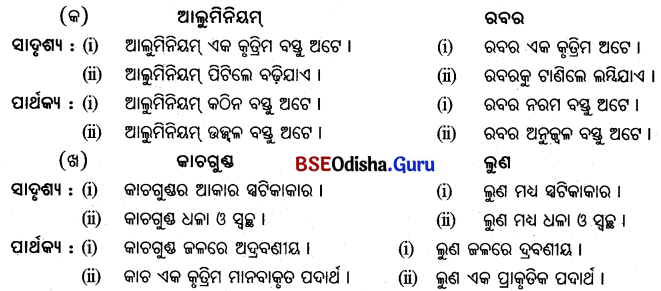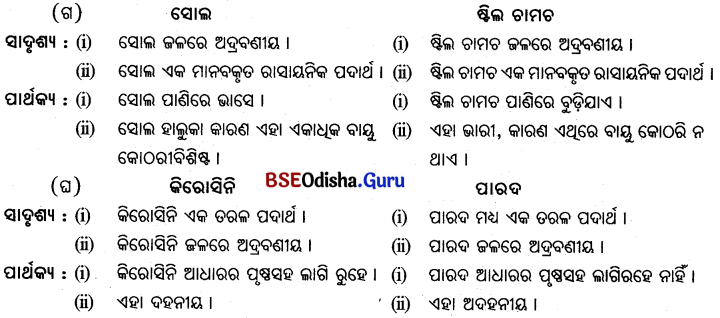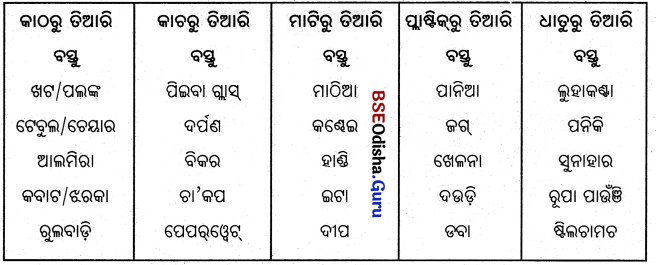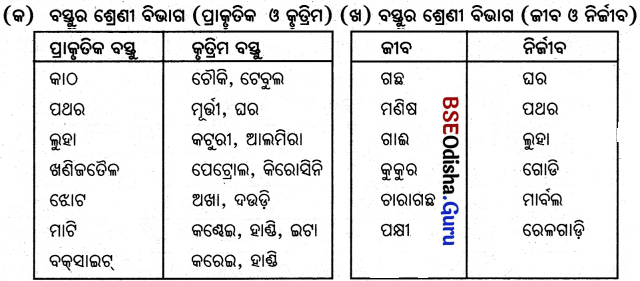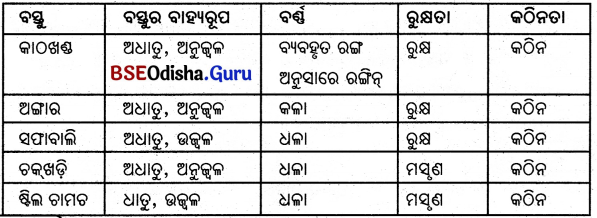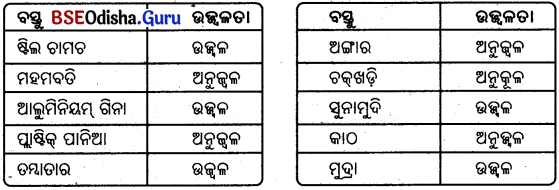Odisha State Board CHSE Odisha Class 12 Sociology Solutions Unit 1 ଭାରତୀୟ ସମାଜର ପରିଚୟ Objective Questions.
CHSE Odisha 12th Class Sociology Unit 1 Objective Questions in Odia Medium
ବସ୍ତୁନିଷ୍ଠ ଓ ଅତିସଂକ୍ଷିପ୍ତ ପ୍ରଶ୍ନୋତ୍ତର
(କ) ଚାରୋଟି ସମ୍ଭାବ୍ୟ ଉତ୍ତର ମଧ୍ୟରୁ ଠିକ୍ ଉତ୍ତରଟି ବାଛି ଲେଖ ।
୧। କେଉଁ ରାଜାଙ୍କ ନାମ ଅନୁସାରେ ଦେଶର ନାମ ଭାରତ ହୋଇଛି ?
(କ) ଭରତ
(ଖ) ଦୁଷ୍ମନ୍ତ
(ଗ) ସମୁଦ୍ରଗୁପ୍ତ
(ଘ) ସୃଦ୍ରଗୁପ୍ତ
Answer:
(କ) ଭରତ
୨। ନିଗ୍ରିଟୋମାନେ ଭାରତର ସର୍ବପ୍ରଥମ ଅଧ୍ୟାସୀ ବୋଲି କିଏ କହିଥିଲେ ?
(କ) ରିସ୍ଲେ
(ଖ) ଜେ.ଏଚ୍.ହଟନ୍
(ଗ) ଏ.ସି.ହଡ଼ନ୍
(ଘ) ବି.ଏସ୍.ଗୁହା
Answer:
(ଖ) ଜେ.ଏଚ୍.ହଟନ୍
୩। ନିମ୍ନଲିଖତ କେଉଁ ନୃବିଜ୍ଞାନୀ ରିସ୍ଲେଙ୍କ ପ୍ରଜାତୀୟ ବିଭାଗୀକରଣ ତୃଟିପୂର୍ଣ ବୋଲି ମତ ଦେଇଛନ୍ତି ।
(କ) ଡି.ଏନ୍.ମଜୁମଦାର
(ଖ) ବି.ଏସ୍. ଗୁପ୍ତା
(ଗ) ଏ.ସି.ହଡ଼ନ୍
(ଘ) ଜେ.ଏଚ୍.ହଟନ୍
Answer:
(କ) ଡି.ଏନ୍.ମଜୁମଦାର
୪। କେଉଁ ପ୍ରଜାତି ଅନ୍ତର୍ଭୁକ୍ତ ନ ଥିବାରୁ ନୃବିଜ୍ଞାନୀମାନେ ରିସ୍ଲେଙ୍କ ପ୍ରଜାତୀୟ ବିଭାଗୀକରଣକୁ ତ୍ରୁଟିପୂର୍ଣ୍ଣ ବୋଲି ଅଭିହିତ କରିଛନ୍ତି ?
(କ) ନରଡ଼ିକ୍
(ଖ) ଆର୍ଯ୍ୟ
(ଗ) ଦ୍ରାବିଡ଼
(ଘ) ନିଗ୍ରିଟୋ
Answer:
(ଘ) ନିଗ୍ରିଟୋ
୫। କିଏ ଭାରତର ଜନସଂଖ୍ୟାକୁ ୫ଟି ପ୍ରଜାତିରେ ବିଭକ୍ତ କରିଛନ୍ତି ?
(କ) ଏ.ସି.ହଡ଼ନ୍
(ଖ) ରିସ୍ଲେ
(ଗ) ଜେ.ଏଚ୍.ହଟନ୍
(ଘ) ବି.ଏସ୍.ଗୁହା
Answer:
(କ) ଏ.ସି.ହଡ଼ନ୍
୬। କିଏ ଭାରତୀୟ ଜନସଂଖ୍ୟାକୁ ପ୍ରାକ୍ ଦ୍ରାବିଡ଼ିଆଜ୍, ଦ୍ରାବିଡ଼ିଆନ୍, ଇଣ୍ଡୋ-ଆର୍ଯ୍ୟାନ୍, ଇଣ୍ଡୋ-ଆଲ୍ପାଇନ୍ ଏବଂ ମଙ୍ଗୋଲିଆନ୍ ଆଦି ଭାବରେ ବିଭକ୍ତ କରିଛନ୍ତି ?
(କ) ରିସ୍ଲେ
(ଖ) ଏ.ସି.ହଡ଼ନ୍
(ଗ) ଜେ.ଏଚ୍.ହଟନ୍
(ଘ) ବି.ଏସ୍.ଗୁହା
Answer:
(ଖ) ଏ.ସି.ହଡ଼ନ୍
୭। କିଏ ଭାରତର ଜନସଂଖ୍ୟାକୁ ନିଗ୍ରିଟୋ, ପ୍ରୋଟୋ ଅଷ୍ଟ୍ରାଲଏଡ, ମଙ୍ଗୋଲଏଜ୍, ମେଡ଼ିଟେରାନିଆନ୍, ୱେଷ୍ଟର୍ନ ବ୍ରୋସିସେଫାଲ୍ ଏବଂ ନର୍ଜିକ୍ ଆଦି ପ୍ରଜାତିରେ ବିଭକ୍ତ କରିଛନ୍ତି ?
(କ) ହଟନ୍
(ଖ) ରିସ୍ଲେ
(ଗ) ଗୁହା
(ଘ) ହଡ଼ନ୍
Answer:
(ଗ) ଗୁହା

୮। କିଏ ଭାରତୀୟ ଜନସଂଖ୍ୟାକୁ ଇଣ୍ଡୋ-ଆର୍ଯ୍ୟନ, ତୁର୍କୋ-ଇରାନିଆନ୍, ସ୍କାଇଥୋଦ୍ରାବିଡ଼ିଆଟ୍, ଦ୍ରାବିଡ଼ିଆନ୍, ମଙ୍ଗୋଲଏଡ, ଆର୍ଯ୍ୟ-ଦ୍ରାବିଡ଼ିଆନ୍ ଓ ମଙ୍ଗୋଲଏକ-ଦ୍ରାବିଡ଼ିଆନ୍ ଆଦି ପ୍ରଜାତିରେ ବିଭକ୍ତ କରିଛନ୍ତି ?
(କ) ଗୁହା
(ଖ) ହଟନ୍
(ଗ) ମକୁମଦାର
(ଘ) ରିସ୍ଲେ
Answer:
(ଘ) ରିସ୍ଲେ
୯। ସ୍ୱତନ୍ତ୍ର ଦୈହିକ ଗୁଣାବଳୀମାନ ଥିବା ଲୋକମାନଙ୍କର ସମଷ୍ଟିକୁ କ’ଣ କହନ୍ତି ?
(କ) ପ୍ରଜାତି
(ଖ) ଜାତି
(ଗ) ଭାଷା
(ଘ) ବର୍ଷ
Answer:
(କ) ପ୍ରଜାତି
୧୦ । ଭାରତ ଭାଷାର ଏକ ସଂଗ୍ରହାଳୟ’’ . କିଏ କହିଥିଲେ ?
(କ) ହରବର୍ଟ ରିସ୍
(ଖ) ଏ.ଆର୍.ଦେଶାଇ
(ଗ) ଜେ.ଏଚ୍.ହଟନ୍
(ଘ) ଏ.ସି.ହଡ଼ନ୍
Answer:
(ଖ) ଏ.ଆର୍.ଦେଶାଇ
୧୧ । ୧୯୬୧ ଜନଗଣନା ଅନୁସାରେ ଭାରତରେ କେତୋଟି ଭାଷା ଅଛି ?
(କ) ୨୦୦୦
(ଖ) ୧୪୫୨
(ଗ) ୧୬୫୨
(ଘ) ୧୫୫୨
Answer:
(ଗ) ୧୬୫୨
୧୨ । ଭାରତର ସମୁଦାୟ ଭାଷାଗୁଡ଼ିକୁ କେତୋଟି ଭାଷାଗତ ପରିବାରରେ ବିଭକ୍ତ କରାଯାଇଛି ?
(କ) ୨
(ଖ) ୫
(ଗ) ୩
(ଘ) ୪
Answer:
(ଘ) ୪
୧୩ ୫ କିଏ ତାଙ୍କ ‘ଭାରତର ଭାଷାଗତ ସର୍ଭେ’ରେ ଉଲ୍ଲେଖ କରିଛନ୍ତି ଯେ ଭାରତରେ ୧୭୯ ଭାଷା ଏବଂ ୫୪୪ ଡାଇଲେକ୍ଟିକ୍ ଅଛି?
(କ) ଗ୍ରୀସନ୍ (Grierson)
(ଖ) ରିସ୍ ଲେ(Risley)
(ଗ) ଗୁହା(Guha)
(ଘ) ହଟନ (Hutton)
Answer:
(କ) ଗ୍ରୀସନ୍ (Grierson)
୧୪ । ତାମିଲ ଭାଷା କେଉଁ ଭାଷା ପରିବାର ଅନ୍ତର୍ଭୁକ୍ତ ଅଟେ ?
(କ) ଆର୍ଯ୍ୟ ଭାଷା ପରିବାର
(ଖ) ଦ୍ରାବିଡ଼ିଆନ୍
(ଗ) ଅଷ୍ଟ୍ରିକ୍
(ଘ) ସିନୋ ତିବେତାନ୍
Answer:
(ଖ) ଦ୍ରାବିଡ଼ିଆନ୍
୧୫ । ଓଡ଼ିଆ ଭାଷା କେଉଁ ଭାଷା ପରିବାର ଅନ୍ତର୍ଭୁକ୍ତ ଅଟେ ?
(କ) ଅଷ୍ଟ୍ରିକ୍
(ଖ) ଦ୍ରାବିଡ଼ିଆନ୍
(ଗ) ଲଣେୃ।-ଆର୍ଯ୍ୟ
(ଘ) ସିନୋ ତିବେତାନ୍
Answer:
(ଗ) ଲଣେୃ।-ଆର୍ଯ୍ୟ
୧୬ । ନିମ୍ନଲିଖତ ଭାଷା ମଧ୍ୟରୁ ଭାରତର ରାଷ୍ଟ୍ରଭାଷା କିଏ ?
(କ) ଇଂରାଜୀ
(ଖ) ଓଡ଼ିଆ
(ଗ) ଊର୍ଦ୍ଧ୍ବ
(ଘ) ହିନ୍ଦୀ
Answer:
(ଘ) ହିନ୍ଦୀ
୧୭ । ଆମ ରାଷ୍ଟ୍ରଭାଷା ହିନ୍ଦୀ କେଉଁ ଭାଷା ପରିବାରଭୁକ୍ତ ଅଟେ ?
(କ) ଇଣ୍ଡୋ-ଆର୍ଯ୍ୟ
(ଖ) ଦ୍ରାବିଡ଼
(ଗ) ଅଷ୍ଟ୍ରିକ୍
(ଘ) ସିନୋ ତିବେତାନ
Answer:
(କ) ଇଣ୍ଡୋ-ଆର୍ଯ୍ୟ
୧୮। ଆମ ସମ୍ବିଧାନ କେତେଗୋଟି ଭାଷାକୁ ସ୍ବୀକୃତି ପ୍ରଦାନ କରିଛି ?
(କ) ୧୫
(ଖ) ୧୮
(ଗ) ୧୯
(ଘ) ୨୧
Answer:
(ଖ) ୧୮
୧୯ । ଭାରତରେ ଅଧିକାଂଶ ଲୋକ କେଉଁ ଭାରତୀୟ ଭାଷାରେ କଥା ହୁଅନ୍ତି ?
(କ) ଇଂରାଜୀ
(ଖ) ତାମିଲ୍
(ଗ) ହିନ୍ଦୀ
(ଘ)
Answer:
(ଗ) ହିନ୍ଦୀ
୨୦ । କେଉଁ ଭାଷା ଆଇନ ହିନ୍ଦୀକୁ ଭାରତର କାର୍ଯ୍ୟକାରୀ ଭାଷା ଭାବେ ଘୋଷଣା କଲା ?
(କ) ୧୯୪୭
(ଖ) ୧୯୫୦
(ଗ) ୧୯୫୧
(ଘ) ୧୯୬୩
Answer:
(ଘ) ୧୯୬୩
୨୧ । ୧୯୩୧ ଜନଗଣନା ଅନୁସାରେ ଭାରତରେ କେତୋଟି ଧାର୍ମିକ ସମୂହ ଥିଲା ?
(କ) ୧୦
(ଖ) ୧୨
(ଗ) ୮
(ଘ) ୬
Answer:
(କ) ୧୦
୨୨ । ସିହା ଏବଂ ସୁନୀ କେଉଁ ଧର୍ମର ଦୁଇଟି ସଂପ୍ରଦାୟ ଅଟନ୍ତି ?
(କ) ହିଦୁ
(ଖ) ଇସ୍ଲାମ୍
(ଗ) ବୌଦ୍ଧ
(ଘ) କୈନ
Answer:
(ଖ) ଇସ୍ଲାମ୍

୨୩। ଶୈବ, ଶାକ୍ତ, ବୈଷ୍ଣବ ଇତ୍ୟାଦି କେଉଁ ଧର୍ମର ସଂପ୍ରଦାୟ ଅଟେ ?
(କ) ଶିଖ୍
(ଖ) ପାର୍ସୀ
(ଗ) ହିନ୍ଦୁ
(ଘ) ବୌଦ୍ଧ
Answer:
(ଗ) ହିନ୍ଦୁ
୨୪ । ହୀନଯାନ ଏବଂ ମହାଯାନ କେଉଁ ଧର୍ମର ଦୁଇ ସଂପ୍ରଦାୟ ଅଟେ ?
(କ) ହିନ୍ଦୁ
(ଖ) ଶିଖ୍
(ଗ) ଜୈନ
(ଘ) ବୌଦ୍ଧ
Answer:
(ଘ) ବୌଦ୍ଧ
୨୫ । ଦିଗମ୍ବର ଓ ଶ୍ୱେତାମ୍ବର କେଉଁ ଧର୍ମର ଦୁଇ ସଂପ୍ରଦାୟ ଅଟେ ?
(କ) ଜୈନ
(ଖ) ବୌଦ୍ଧ
(ଗ) ହିନ୍ଦୁ
(ଘ) ଶିଖ୍
Answer:
(କ) ଜୈନ
୨୬ । ଭାରତରେ ହିନ୍ଦୁମାନଙ୍କର ସଂଖ୍ୟା ସମୁଦାୟ ଜନସଂଖ୍ୟାର କେତେ ଭାଗ ?
(କ) ୨୦
(ଖ) ୮୨
(ଗ) ୮୫
(ଘ) ୮୦
Answer:
(ଖ) ୮୨
୨୭ । ପ୍ରୋଟେଷ୍ଟାଣ୍ଟ ଏବଂ କ୍ୟାଥୋଲିକ୍ କେଉଁ ଧର୍ମର ଦୁଇ ସଂପ୍ରଦାୟ ଅଟେ ?
(କ) ଶିଖ୍
(ଖ) ଖ୍ରୀଷ୍ଟ
(ଗ) ହିନ୍ଦୁ
(ଘ) କୈନ
Answer:
(ଖ) ଖ୍ରୀଷ୍ଟ
୨୮ । ନିମ୍ନଲିଖୂତ ଧର୍ମମାନଙ୍କ ମଧ୍ୟରୁ କେଉଁ ଧର୍ମ ଦ୍ଵିତୀୟ ବୃହତ୍ତମ ଧାର୍ମିକ ସମୂହ ଅଟେ ?
(କ) ଶିଖ୍
(ଖ) ହିନ୍ଦୁ
(ଗ) ଇସ୍ଲାମ୍
(ଘ) କୈନ
Answer:
(ଗ) ଇସ୍ଲାମ୍
୨୯ । କେଉଁ ମୋଗଲ ସମ୍ରାଟ ହିନ୍ଦୁ ମୁସଲିମ୍ ଏକତା ପ୍ରତିଷ୍ଠା ପାଇଁ ଉଦ୍ୟମ କରିଥିଲେ ?
(କ) ବାବର
(ଖ) ହୁମାୟୁନ୍
(ଗ) ଆକବର
(ଘ) ଶାହାକାହାନ୍
Answer:
(ଗ) ଆକବର
୩୦ । ନିମ୍ନଲିଖ କେଉଁ ଭାଷା ପ୍ରାଚୀନ ଭାରତରେ ଏକତା ଆଣିବାରେ ସହାୟକ ହେଉଥିଲା ?
(କ) ହିଦା
(ଖ) ଇଂରାଜୀ
(ଗ) ଊର୍ଦ୍ଧ୍ବ
(ଘ) ସଂସ୍କୃତ
Answer:
(ଘ) ସଂସ୍କୃତ
୩୧ । ‘‘ଭାରତର ଏକତା ମୁଖ୍ୟତଃ ଧାର୍ମିକ ଅଟେ’– ଏକଥା କିଏ କହିଥିଲେ ?
(କ) ଏସ୍.ଏନ୍.ଶ୍ରୀନିବାସ
(ଖ) ମାକାଇଭର
(ଗ) ଏ.ଆର୍.ଦେଶାଇ
(ଘ) ସି.ଏଚ୍.କୁଲେ
Answer:
(କ) ଏସ୍.ଏନ୍.ଶ୍ରୀନିବାସ
୩୨ । ଭାରତର ଚତୁଃପାର୍ଶ୍ବରେ ପ୍ରାକୃତିକ ପ୍ରାଚୀର ଏହାର କେଉଁ ଏକତାକୁ ଦର୍ଶାଇଥାଏ ?
(କ) ରାଜନୈତିକ
(ଖ) ଭୌଗୋଳିକ
(ଗ) ସାଂସ୍କୃତିକ
(ଘ) ଧାମିକ
Answer:
(ଖ) ଭୌଗୋଳିକ
୩୩ । ଭାରତର ଅତି ପ୍ରାଚୀନ ସୃଷ୍ଟି ଏହାର କେଉଁ ଏକତାକୁ ଦର୍ଶାଇଥାଏ ?
(କ) ଭୌଗୋଳିକ
(ଖ) ରାଜନୈତିକ
(ଗ) ଐତିହାସିକ
(ଘ) ପୁରୁଶା
Answer:
(ଗ) ଐତିହାସିକ
୩୪ । ସର୍ବପ୍ରଥମେ ଭାରତରେ ମନୁଷ୍ୟର ଆର୍ବିଭାବ କେବେ ହୋଇଥିଲା ?
(କ) ୫୦୦୦ ବର୍ଷ ପୂର୍ବେ
(ଖ) ୨୦୦୦ ବର୍ଷ ପୂର୍ବେ
(ଗ) ୧୦,୦୦୦ ବର୍ଷ ପୂର୍ବେ
(ଘ) ୫,୦୦,୦୦୦ ବର୍ଷ ପୂର୍ବେ
Answer:
(ଘ) ୫,୦୦,୦୦୦ ବର୍ଷ ପୂର୍ବେ
୩୫ । ହିନ୍ଦୁ ଉପତ୍ୟକାର ସଭ୍ୟତା କେବେ ସୃଷ୍ଟି ହୋଇଥିଲା ?
(କ) ଖ୍ରୀ.ପୂ. ୨୫୦୦
(ଖ) ଖ୍ରୀ.ପୂ. ୧୫୦୦
(ଗ) ଖ୍ରୀ.ପୂ. ୧୭୦୦
(ଘ) ଖ୍ରୀ.ପୂ. ୫୦୦୦
Answer:
(କ) ଖ୍ରୀ.ପୂ. ୨୫୦୦
୩୬ । ଭାରତର ଭୌଗୋଳିକ ଅଞ୍ଚଳ ଗୁଜରାଟରୁ ଆସାମ ପର୍ଯ୍ୟନ୍ତ କେତେ ମାଇଲ୍ ପରିବ୍ୟାପ୍ତ ଅଟେ ?
(କ) ୨୦୦୦ ମାଇଲ୍
(ଖ) ୧୫୦୦ ମାଇଲ୍
(ଗ) ୩୦୦୦ ମାଇଲ୍
(ଘ) ୨୫୦୦ ମାଇଲ୍
Answer:
(ଖ) ୧୫୦୦ ମାଇଲ୍
୩୭ । ଇଣ୍ଡିଆ ଶବ୍ଦଟି କେଉଁ ଶବ୍ଦରୁ ଆସିଛି ?
(କ) ଭାରତ
(ଖ) ଇଦୁ
(ଗ) ଇଣ୍ଡସ୍
(ଘ) ଗଙ୍କ।
Answer:
(ଗ) ଇଣ୍ଡସ୍
୩୮ । ଭାରତର ପବିତ୍ର ଭୌଗୋଳିକତା ଏହାର କେଉଁ ଏକତାକୁ ଦର୍ଶାଇଥାଏ ?
(କ) ରାଜନୈତିକ
(ଖ) ଭୌଗୋଳିକ
(ଗ) ଧାର୍ମିକ
(ଘ) ସାଂସ୍ମତିକ
Answer:
(ଘ) ସାଂସ୍ମତିକ
୩୯ । ଭାରତର ଅବସ୍ଥିତି କେଉଁ ଗୋଲାର୍ଦ୍ଧରେ ରହିଅଛି ?
(କ) ଦକ୍ଷିଣ
(ଖ) ଉତ୍ତର
(ଗ) ଉତ୍ତୟ
(ଘ) କୌଣସିଟି ନୁହେଁ
Answer:
(ଗ) ଉତ୍ତୟ
୪୦ । ଆମ ଦେଶର ସୀମାକୁ କେତୋଟି ଦେଶ ଲାଗିଛି ?
(କ) ଦୁଇଟି
(ଖ) ସାତଟି
(ଗ) ପାଞ୍ଚ
(ଘ) ଚାରିଟି
Answer:
(ଖ) ସାତଟି
୪୧ । ହିମାଳୟର ଉତ୍ତର ଭାଗକୁ କ’ଣ କୁହାଯାଏ ?
(କ) ହିମାଳ
(ଖ) ହିମାଦ୍ରି
(ଗ) ଣିୱାଲିକ୍
(ଘ) ଗାଙ୍ଗେୟ ସମତଳଭୂମି
Answer:
(ଖ) ହିମାଦ୍ରି
୪୨ । ହିମାଳୟର ଦକ୍ଷିଣଭାଗର ଅଂଶବିଶେଷକୁ କ’ଣ କୁହାଯାଏ ?
(କ) ହିମାଦ୍ରି
(ଖ) ହିମାଚଳ
(ଗ) ପଞ୍ଜାବ
(ଘ) ସିଲିକ୍
Answer:
(ଘ) ସିୱାଲିକ୍
୪୩ । ଭାରତର ମଧ୍ୟଭାଗରେ କେଉଁ ପର୍ବତମାଳା ରହିଅଛି ?
(କ) ପୂର୍ବଘାଟ
(ଖ) ପଶ୍ଚିମଘାଟ
(ଗ) ମଧ୍ୟପ୍ରଦେଶ
(ଘ) ବିନ୍ଧ୍ୟ ଓ ସାତପୁରା
Answer:
(ଘ) ବିନ୍ଧ୍ୟ ଓ ସାତପୁରା

୪୪ । ସୁନ୍ଦରବନ ତ୍ରିକୋଣଭୂମି କେଉଁ ନଦୀର ମୁହାଣରେ ସୃଷ୍ଟି ହୋଇଅଛି ?
(କ) ନର୍ମଦା ଓ ତାୟୀ
(ଖ) କୃଷ୍ଣା ଓ କାବେରୀ
(ଗ) ଗଙ୍ଗା ଓ ଯମୁନା
(ଘ) ଗଙ୍ଗା ଓ ବ୍ରହ୍ମପୁତ୍ର
Answer:
(ଗ) ଗଙ୍ଗା ଓ ବ୍ରହ୍ମପୁତ୍ର
୪୫ । ଭାରତର ଉତ୍ତରସ୍ଥ ସମତଳଭୂମିର ଦକ୍ଷିଣ ଭାଗରେ କ’ଣ ଅବସ୍ଥିତ ?
(କ) ଗାଙ୍ଗେୟ ସମତଳଭୂମି
(ଖ) ଦାକ୍ଷିଣାତ୍ୟ ମାଳଭୂମି
(ଗ) ସାମୁଦ୍ରିକ ଉପକୂଳୀୟ ସମତଳ ଅଞ୍ଚଳ
(ଘ) ପଶ୍ଚିମଘାଟ ପର୍ବତମାଳା
Answer:
(ଖ) ଦାକ୍ଷିଣାତ୍ୟ ମାଳଭୂମି
୪୬ । ୨୦୧୧ ଜନଗଣନା ଅନୁସାରେ ଦେଶର ଜନସଂଖ୍ୟାର ଘନତା ବର୍ଗ କି.ମି. ପ୍ରତି କେତେ ରହିଅଛି ?
(କ) ୧୧୭
(ଖ) ୭୭
(ଗ) ୩୨୧
(ଘ) ୩୮୪
Answer:
(ଘ) ୩୮୪
୪୭ । ଭାରତର କେଉଁ ରାଜ୍ୟ ହେଉଅଛି କମ୍ ଜନସଂଖ୍ୟା ଘନତ୍ବ ରାଜ୍ୟ ?
(କ) କେରଳ
(ଖ) ଆସାମ
(ଗ) ଅରୁଣାଚଳ ପ୍ରଦେଶ
(ଘ) ଓଡ଼ିଶା
Answer:
(ଗ) ଅରୁଣାଚଳ ପ୍ରଦେଶ
୪୮ । ୨୦୧୧ ମସିହାରେ ଭାରତର ଆୟୁ ପ୍ରତ୍ୟାଶା କେତେ ରହିଅଛି ?
(କ) ୫୮ ବର୍ଷ
(ଖ) ୬୫ ବର୍ଷ
(ଗ) ୭୦ ବର୍ଷ
(ଘ) ୫୦ବର୍ଷ
Answer:
(ଗ) ୭୦ ବର୍ଷ
୪୯ । ଭାରତ ସମଗ୍ର ଜନସଂଖ୍ୟାର କେତେ ଭାଗ ମହିଳା ଜନସଂଖ୍ୟା ଅଛି ?
(କ) ୫୧.୫%
(ଖ) ୪୮.୫%
(ଗ) ୫୦%
(ଘ) ୬୧%
Answer:
(ଖ) ୪୮.୫%
୫୦ । ୨୦୧୧ ଜନଗଣନା ଅନୁସାରେ ଭାରତର କେତେ ପ୍ରତିଶତ ଲୋକ ଗ୍ରାମାଞ୍ଚଳରେ ବସବାସ କରନ୍ତି ?
(କ) ୩୧.୨୦
(ଖ) ୮୦
(ଗ) ୬୮.୮୦
(ଘ) ୮୫
Answer:
(ଗ) ୬୮.୮୦
୫୧ । ଭାରତର ସର୍ବୋଚ୍ଚ ଜନସଂଖ୍ୟା ବିଶିଷ୍ଟ ନଗରଟି କିଏ ?
(କ) ଦିଲ୍ଲୀ
(ଖ) ଜଜଲିତା
(ଗ) ମୁମ୍ବାଇ
(ଘ) ଚେନୃ।ଇ
Answer:
(ଗ) ମୁମ୍ବାଇ
୫୨ । ଭାରତର ସହରୀ ଜନସଂଖ୍ୟାର ଅଭିବୃଦ୍ଧିର କାରଣ କ’ଣ ?
(କ) ଦାରିଦ୍ର୍ୟ
(ଖ) ସହର ଚଳଶି
(ଗ) ଜନସଂଖ୍ୟାର ସ୍ଥାନାନ୍ତରଣ ଓ ଦ୍ରୁତ ସହରୀକରଣ
(ଘ) ବେକାର
Answer:
(ଗ) ଜନସଂଖ୍ୟାର ସ୍ଥାନାନ୍ତରଣ ଓ ଦ୍ରୁତ ସହରୀକରଣ
୫୩ ’ଭୌଗୋଳିକ ଅଞ୍ଚଳ ଦୃଷ୍ଟିକୋଣରୁ ଭାରତ ବିଶ୍ବର ବୃହତ୍ ରାଷ୍ଟ୍ରଗୁଡ଼ିକ ମଧ୍ୟରେ କେଉଁ ସ୍ଥାନରେ ରହିଅଛି ?
(କ) ତୃତୀୟ
(ଖ) ଦ୍ବିତୀୟ
(ଗ) ସପ୍ତମ
(ଘ) ଅଷ୍ଟମ
Answer:
(ଗ) ସପ୍ତମ
୫୪ । ବିଶ୍ଵ ଜନସଂଖ୍ୟାର ଶତକଡ଼ା କେତେ ଭାଗ ଲୋକ ଭାରତରେ ବାସ କରନ୍ତି ?
(କ) ୨.୪%
(ଖ) ୧୭.୫%
(ଗ) ୧୭.୬%
(ଘ) ୯.୯୬ %
Answer:
(କ) ୨.୪%
୫୫ । ଭାରତର ସଂପୂର୍ଣ୍ଣ କ୍ଷେତ୍ରଫଳ କେତେ ?
(କ) ୩୨ ଲକ୍ଷ ୮୭ ହଜାର ୨୬୩ ବର୍ଗ କିଲୋମିଟର
(ଖ) ୨୦ ଲକ୍ଷ ୭୫ ହଜାର ୪୦୦ ବର୍ଗ କିଲୋମିଟର
(ଗ) ୩୦ ଲକ୍ଷ ୮୦ ହଜାର ୫୦୦ ବର୍ଗ କିଲୋମିଟର
(ଘ) ୨୫ ଲକ୍ଷ ୮୭ ହଜାର ୨୬୩ ବର୍ଗ କିଲୋମିଟର
Answer:
(କ) ୩୨ ଲକ୍ଷ ୮୭ ହଜାର ୨୬୩ ବର୍ଗ କିଲୋମିଟର
୫୬ । ଭାରତର ଜନସଂଖ୍ୟା ୨୦୧୧ ଜନଗଣନା ତଥ୍ୟାନୁସାରେ କେତେ ଅଟେ ?
(କ) ୧୧୮କୋଟି ୮୦ ଲକ୍ଷ ୫ ହଜାର ୨୦୦
(ଖ) ୧୦୨ କୋଟି ୮୬ ଲକ୍ଷ ୧୦ ହଜାର ୩୨୮
(ଗ) ୧୨୧ କୋଟି ୧ ଲକ୍ଷ ୯୩ ହଜାର ୪୨୨
(ଘ) ୧୦୫ କୋଟି ୯୦ ଲକ୍ଷ ୨୦ ହଜାର ୫୩୦
Answer:
(ଗ) ୧୨୧ କୋଟି ୧ ଲକ୍ଷ ୯୩ ହଜାର ୪୨୨
୫୭ । ‘‘ଭାରତ ଏକ ନିର୍ଦ୍ଦିଷ୍ଟ ପରିସର ମଧ୍ୟରେ ପାର୍ଥକ୍ୟ ଥିବା ଏବଂ ବହୁଧା ସ୍ବତନ୍ତ୍ର ବଂଶଗତ ଗୁଣ ଧାରଣା କରିଥିବା ଏକ ବୃହତ୍ ଜୈବିକ ମାନବ ସମୂହ ପ୍ରଜାତି ଅଟେ’’ ଏହା କାହାର ମତ ?
(କ) ପ୍ରଫେସର ଡି. ଏନ୍ ମଜୁମ୍ଦାର
(ଖ) ସାର ହର୍ବଟ୍ ରିଜଲେ
(ଗ) ଏ.ଡବ୍ଲ୍ୟୁ. ଗ୍ରୀନ୍
(ଘ) ପ୍ରଫେସର ସି.ବି. ମେମୋରିଆ
Answer:
(ଗ) ଏ.ଡବ୍ଲ୍ୟୁ. ଗ୍ରୀନ୍
୫୮ । ‘ଟ୍ରାଇବାଲ୍ ଡେମୋଗ୍ରାଫି ଅଫ୍ ଇଣ୍ଡିଆ’ ପୁସ୍ତକର ଲେଖକ କିଏ ?
(କ) ବି. କୁପୁସ୍ୱାମୀ
(ଖ) ରବିନ୍ ଫକସ୍
(ଗ) ଡି.ଏଚ୍. ମଜୁମ୍ଦାର
(ଘ) ସି.ବି.ମେମୋରିଆ
Answer:
(ଘ) ସି.ଜି.ମେମୋରିଆ
(ଖ) ଶୂନ୍ୟସ୍ଥାନ ପୂରଣ କର ।
୧। _____________ ବିଭିନ୍ନତାରେ ଏକତାର ଏକ ସୁନ୍ଦର ଉଦାହରଣ ।
Answer:
ଭାରତ
୨। ______________ ନଦୀର ନାମ ଅନୁସାରେ ଭାରତର ନାମ ଇଣ୍ଡିଆ ହୋଇଛି ।
Answer:
ଇଣ୍ଡସ୍ ବା ସିନ୍ଧୁ

୩ । ସିନ୍ଧୁ ନଦୀ ବର୍ତ୍ତମାନ_____________ ଦେଶରେ ଅଛି ।
Answer:
ପାକିସ୍ତାନ
୪। _________________ ଆକ୍ରମଣକାରୀମାନେ ଭାରତକୁ ହିନ୍ଦୁସ୍ଥାନ କହିଥିଲେ ।
Answer:
ମୁସଲିମ୍
୫। ସଂପ୍ରତି ଭାରତର ଭୌଗୋଳିକ ଅଞ୍ଚଳ କାଶ୍ମୀରରୁ କେପ୍ କମୋରିନ୍ ପର୍ଯ୍ୟନ୍ତ ______________ ମାଇଲ୍ ଏବଂ ଗୁଜରାଟରୁ ଆସାମ ପର୍ଯ୍ୟନ୍ତ______________ ମାଇଲ୍ ପର୍ଯ୍ୟନ୍ତ ପରିବ୍ୟାପ୍ତ ।
Answer:
୨୦୦୦, ୧୫୦୦
୬। ଧାର୍ମିକ, ଭାଷାଗତ ଓ ଦୈହିକ ଗୁଣ ଉପରେ ପର୍ଯ୍ୟବସିତ ସାମୂହିକ ପାର୍ଥକ୍ୟକୁ _______________ କରନ୍ତି ।
Answer:
ବିଭିନ୍ନତା
୭। କେତେଗୁଡ଼ିଏ ସ୍ୱତନ୍ତ୍ର ଦୈହିକ ଲକ୍ଷଣ ଥିବା ଲୋକଙ୍କର ସମଷ୍ଟିକୁ_____________ କୁହାଯାଏ ।
Answer:
ପ୍ରଜାତି
୮। ହର୍ବର୍ଟ ରିସ୍ଲେ ଭାରତୀୟ ଜନସଂଖ୍ୟାକୁ ______________ ଟି ପ୍ରଜାତୀୟ ପ୍ରକାରରେ ବର୍ଗୀକରଣ କରିଛନ୍ତି ।_______________
Answer:
୭
୯ । ବି.ଏସ୍.ଗୁହା ଭାରତୀୟ ଜନସଂଖ୍ୟାକୁ ______________ ଟି ପ୍ରଜାତିରେ ବିଭାଜିତ କରିଛନ୍ତି ।
Answer:
୬
୧୦ | _____________ ରିସ୍କ ବର୍ଗୀକରଣକୁ ଏକ ଭାଷାଗତ ବିଭାଜନ ବୋଲି କହି ସମାଲୋଚନା କରିଛନ୍ତି ।
Answer:
ଡି.ଏନ୍.ମଜୁମଦାର
୧୧ । _____________ ଭାରତୀୟ ଜନସଂଖ୍ୟାକୁ ୫ଟି ପ୍ରଜାତୀୟ ପ୍ରକାରରେ ବିଭାଜିତ କରିଛନ୍ତି ।
Answer:
ଏ.ସି.ହଡ଼ନ୍
୧୨ । ନିଗ୍ରିଟୋମାନେ ଭାରତର ପ୍ରଥମ ଅଧିବାସୀ ଥିଲେ ବୋଲି ____________ ମତ ଦେଇଥିଲେ ।
Answer:
ଜେ.ଏଚ୍.ହଟନ୍
୧୩ । _____________ ଙ୍କ ମତରେ ଭାରତ ଭାଷାର ଏକ ସଂଗ୍ରହାଳୟ ଅଟେ ।
Answer:
ଏ.ଆର୍.ଦେଶାଇ
୧୪ । ୧୯୬୧ ଜନଗଣନା ଅନୁସାରେ ଭାରତରେ _____________ ଟି ଭାଷା ଓ କଥାତ ଭାଷା ରହିଛି ।
Answer:
୧୬୫୨
୧୫ । ଭାରତର ସମସ୍ତ ଭାଷାକୁ ମୁଖ୍ୟତଃ ______________ ଟି ଭାଷା ପରିବାରଭୁକ୍ତ କରାଯାଇଛି ।
Answer:
୪
୧୬ । ___________ ଆମର ଜାତୀୟ ଭାଷା ଅଟେ ।
Answer:
ହିଦା
୧୭ । ଆମ ସମ୍ବିଧାନ ସମୁଦାୟ ___________ ଟି ଭାଷାକୁ ସ୍ବୀକୃତି ପ୍ରଦାନ କରିଛି ।
Answer:
୧୮
୧୮ । ହିନ୍ଦୀ _____________ ଭାଷା ପରିବାରଭୁକ୍ତ ଅଟେ ।
Answer:
ଇଣୋୁ-ଆର୍ପ୍ୟ
୧୯। ____________ ଧର୍ମ ଭାରତର ଏକ ପ୍ରମୁଖ ଧର୍ମ ଅଟେ ।
Answer:
ହିନ୍ଦୁ
୨୦ । ସମୁଦାୟ ଜନସଂଖ୍ୟାର _____________ ଭାଗରୁ ଊର୍ଦ୍ଧ୍ବ ଲୋକ ହିନ୍ଦୁ ଧର୍ମାବଲମ୍ବୀ ଅଟନ୍ତି ।
Answer:
୮୨
୨୧ । ଭାରତରେ ମୁସ୍ଲିମ୍ଙ୍କ ସଂଖ୍ୟା ସମୁଦାୟ ଜନସଂଖ୍ୟାର ____________ ଭାଗରୁ ଊର୍ଦ୍ଧ୍ବ ଅଟେ ।
Answer:
୧୨
୨୨। ______________ ଧର୍ମ ଏକ ବହୁ ସଂପ୍ରଦାୟ ବିଶିଷ୍ଟ ଧର୍ମ ଅଟେ ।
Answer:
ହିନ୍ଦୁ
୨୩ । ଦିଗମ୍ବର ଓ ଶ୍ୱେତାମ୍ବର ______________ ଧର୍ମର ଦୁଇ ପ୍ରମୁଖ ସଂପ୍ରଦାୟ ଅଟେ ।
Answer:
ଜୈନ
୨୪ । ହୀନଯାନ ଓ ମହାଯାନ ____________ ଧର୍ମର ଦୁଇ ପ୍ରଧାନ ସଂପ୍ରଦାୟ ଅଟେ ।
Answer:
ବୌଦ୍ଧ
୨୫ । _____________ ସଭ୍ୟତା ପୃଥିବୀର ସବୁଠୁ ପ୍ରାଚୀନ ସଭ୍ୟତା ଅଟେ ।
Answer:
ସିନ୍ଧୁ ଉପତ୍ୟକାର

୨୬ । ___________ ବର୍ଷ ପୂର୍ବେ ପ୍ରଥମ ମନୁଷ୍ୟର ଆର୍ବିଭାବ ଭାରତରେ ଘଟିଥିଲା ବୋଲି ବିଶ୍ବାସ କରାଯାଏ ।
Answer:
୫,୦୦,୦୦୦
୨୭ । ଭାରତର ସମୁଦାୟ ଭୌଗୋଳିକ ଅଞ୍ଚଳ ହେଉଛି ___________ ବର୍ଗ କି.ମି. ।
Answer:
୩୨,୮୦,୪୮୩
୨୮। _____________ ଏକ ଧର୍ମନିରପେକ୍ଷ ଦେଶ ।
Answer:
ଭାରତ
୧୯। _____________ ଙ୍କ ମତରେ ଭାରତର ଏକତା ମୁଖ୍ୟତଃ ଧାର୍ମିକ ଅଟେ ।
Answer:
ଶ୍ରୀନିବାସ
୩୦। ____________ ର ବାସଗୃହ କୁହାଯାଏ ।
Answer:
ବରଫ
୩୧ । ପୌରାଣିକ କିମ୍ବଦନ୍ତୀରୁ ଜଣାପଡ଼େ _______________ ଙ୍କ ନାମାନୁସାରେ ଆମ ଦେଶର ନାମ ଭାରତବର୍ଷ ଅଟେ |
Answer:
ଭରତ
୩୨ । ଭାରତ ________________ ମହାଦେଶର ଏକ ଉପଦ୍ୱୀପ ଅଟେ ।
Answer:
ଏସିଆ
୩ । ଭାରତ ଏକ ____________ ରାଷ୍ଟ୍ର ଅଟେ ।
Answer:
ଧର୍ମନିରପେକ୍ଷ
୩୪ । ଭାରତ _____________ ବୃହତ୍ତମ ରାଷ୍ଟ୍ର ରୂପେ ଖ୍ୟାତିଲାଭ କରିଅଛି ।
Answer:
ସପ୍ତମ
୩୫ । ଭାରତ ବିଶ୍ବର _________ ଜନବହୁଳ ରାଷ୍ଟ୍ର ଅଟେ ।
Answer:
ଦିୃତାୟ
୩୬ । ୨୦୦୧ ଜନଗଣନାନୁଯାୟୀ ଭାରତର ଜନସଂଖ୍ୟା _________ କୋଟି __________ ଲକ୍ଷ _________ ହଜାର ___________ ଅଟେ ।
Answer:
୧୦୨ କୋଟି ୮୬ ଲକ୍ଷ ୧୦ ହଜାର ୩୨୮ ।
୩୭ । ଭାରତର ଇତିହାସ ___________ ଅଟେ ।
Answer:
ଅତି ପ୍ରାଚୀନ
୩୮ । ଭାରତର ଭୌଗୋଳିକ ପରିସୀମା ପୂର୍ବରୁ ପଶ୍ଚିମକୁ ______________ କିଲୋମିଟର ।
Answer:
୨, ୯୩୩
୩୯ । ଭାରତର ଭୌଗୋଳିକ ପରିସୀମା ଉତ୍ତରରୁ ଦକ୍ଷିଣକୁ ____________ କିଲୋମିଟର ।
Answer:
୩, ୨୧୪
୪୦ । ଭାରତର କ୍ଷେତ୍ରଫଳ __________ ବର୍ଗ କିଲୋମିଟର ।
Answer:
୩୨ ଲକ୍ଷ ୮୭ ହଜାର ୨୬୩
୪୧ । ହିମାଳୟ ପାର୍ବତ୍ୟାଞ୍ଚଳ, ଦାକ୍ଷିଣାତ୍ୟ ମାଳଭୂମି, ____________ ଓ ____________ ଅଞ୍ଚଳକୁ ନେଇ ଭାରତ ନିଜର ପରିଚୟ ପ୍ରଦାନ କରେ ।
Answer:
ଉତ୍ତରସ୍ଥ ସମତଳଭୂମି, ଉପକୂଳବର୍ତ୍ତୀ ସମତଳ
୪୨ । ସାଧାରଣ ___________ ଗୁଣଗୁଡ଼ିକ ପ୍ରଜାତିର ସଦସ୍ୟମାନେ ଧାରଣ କରିଥା’ନ୍ତି ।
Answer:
ବଂଶୃଗତ
୪୩ । ଆର୍ଯ୍ୟ, ଦ୍ରାବିଡ଼ୀୟ ପ୍ରଜାତି ଏକ ____________ ପ୍ରଜାତି ଅଟନିୃ ।
Answer:
ମିଶି୍ତ
୪୪ । ମଙ୍ଗୋଲୀୟ ଓ ଦ୍ରାବିଡ଼ମାନଙ୍କ ଆନ୍ତଃବିବାହରୁ _______________ ପ୍ରଜାତିର ସୃଷ୍ଟି ହୋଇଅଛି ।
Answer:
ମଙ୍ଗୋଲୀୟ- ଦ୍ରାବିଡ଼ୟ
୪୫ । ଦ୍ରାବିଡ଼ୀୟମାନେ ସାଧାରଣତଃ ଭାରତର _____________ ଭାଗରେ ବସତି ସ୍ଥାପନ କରିଅଛନ୍ତି ।
Answer:
ଦକ୍ଷିଣ
୪୬। ______________ ସର୍ବ ପୁରାତନ ଜଙ୍ଗଲୀ ଜନଜାତି ବୋଲି ନୃ-ବିଜ୍ଞାନୀ ଏ.ସି. ହାଚ୍ଛନ୍ ମତପୋଷଣ କରିଅଛନ୍ତି ।
Answer:
ପ୍ର।କ୍-ଦ୍ରାବିଡ଼ୟ
୪୭ । ମାଲୟେସିଆର ________________ ପ୍ରଜାତି ସର୍ବପ୍ରଥମେ ଉତ୍ତର ଭାରତରେ ପ୍ରବେଶ କରି ହିମାଳୟର ପାଦଦେଶରେ ବାସ କରିଥିଲେ।
Answer:
ନିଗ୍ରିଟୋ
୪୮ । ________________ ଜାତୀୟ ପ୍ରଜାତି ସିନ୍ଧୁ ସଭ୍ୟତାର ପ୍ରତିଷ୍ଠାତା ବୋଲି ବିଶ୍ଵାସ କରାଯାଏ । _____________
Answer:
ପ୍ରୋଟୋ-ଅଷ୍ଟ୍ରେଲୀୟ

୪୯ । ହିମାଳୟରେ ବାସ କରୁଥିବା ନାଗା ଜନଜାତି ___________________ ଜାତୀୟ ପ୍ରଜାତି ଅଟେ ।
Answer:
ମଙ୍ଗୋଲୀୟ
୫୦ । ପ୍ରାଚ୍ୟ ଦେଶବାସୀୟ ପ୍ରଜାତିକୁ ____________ ପ୍ରଜାତି କୁହାଯାଏ ।
Answer:
ସେମେଟିକ୍
୫୧ । ଭାରତୀୟ ସମ୍ବିଧାନର _______________ ପରିଚ୍ଛେଦରେ ୨୨ ଗୋଟି ଭାଷାକୁ ସ୍ବୀକୃତି ପ୍ରଦାନ କରାଯାଇଅଛି ।
Answer:
ଅଷ୍ଟମ
୫୨ । ୨୦୦୧ ଜନଗଣନାନୁଯାୟୀ ଭାରତର ଜନସଂଖ୍ୟା ______________ ଅଟେ ।
Answer:
୧୦୨ କୋଟିରୁ ଉର୍ଦ୍ଧ୍ବ
୫୩ । ଭାରତୀୟ ସମ୍ବିଧାନର ଅଷ୍ଟମ ପରିଚ୍ଛେଦରେ _______________ ଗୋଟି ଭାଷାକୁ ସ୍ବୀକୃତି ପ୍ରଦାନ କରାଯାଇଅଛି ।
Answer:
୨୨
୫୪ । ସର୍ବବୃହତ୍ ଭାଷା ଓ ମାତୃଭାଷାଗୁଡ଼ିକ _______________ ଭାଷାର ଅନ୍ତର୍ଗତ ଅଟନ୍ତି ।
Answer:
ଇଣ୍ଡୋ-ଆର୍ଯ୍ୟଭାଷା
୫୫ । ଓଡ଼ିଶାର ପାର୍ବତ୍ୟାଞ୍ଚଳରେ ବାସ କରୁଥିବା ଜନଜାତିମାନେ ______________ ଉପଭାଷା ବ୍ୟବହାର କରିଥା’ନ୍ତି ।
Answer:
କୋଇ
୫୬ । ଧର୍ମଗତ ବିବିଧତା ଭାରତର ଜାତୀୟ ସଂହତିର ____________ ଅଟନ୍ତି ।
Answer:
ଭପାଦାନ
୫୭ । କେ.ଏମ୍. ପାନିକରଙ୍କ ମତରେ ହିନ୍ଦୁଧର୍ମର ସାମାଜିକ ସଂରଚନା ___________ ଓ __________ ମୌଳିକ ଅନୁଚ୍ଛେଦ ସହିତ ଜଡ଼ିତ ।
Answer:
ଜାତି ବ୍ୟବସ୍ଥା, ଯୌଥ ପରିବାର
୫୮ । ଖ୍ରୀଷ୍ଟଧର୍ମର ମୂଳମନ୍ତ୍ର ______________ ଅଟେ ।
Answer:
ପ୍ରେମ
୫୯ । ବୁଦ୍ଧଦେବ ଦର୍ଶାଇଥବା ମାର୍ଗକୁ ___________ ମାର୍ଗ କୁହାଯାଏ ।
Answer:
ଆର୍ଯ୍ୟ ଅଷ୍ଟାଙ୍ଗ
୬୦ । ଇତିହାସର ସୁଦୀର୍ଘ କାହାଣୀ ଓ ଘଟଣାଗୁଡ଼ିକୁ ବିବିଧତା ମଧ୍ୟରେ ____________ ର ମୂଳମନ୍ତ୍ରରେ ବାନ୍ଧି ରଖୂରିଅଛି ।
Answer:
ଏକତା
୬୧ । ଭାରତର ଭୌଗୋଳିକ ପରିସୀମା ___________ ଠାରୁ ___________ ପର୍ଯ୍ୟନ୍ତ ବ୍ୟାପ୍ତ ଅଟେ ।
Answer:
କାଶ୍ମୀର କୁମାରିକା
(ଗ) ଭ୍ରମ ସଂଶୋଧନ କର ।
୧। ଓଡ଼ିଶା ବିଭିନ୍ନତାରେ ଏକତାର ଏକ ସୁନ୍ଦର ଉଦାହରଣ ଅଟେ ।
Answer:
ଭାରତ ବିଭିନ୍ନତାରେ ଏକତାର ଏକ ସୁନ୍ଦର ଦାହରଣ ଅଟେ ।
୨। ଆମ ଦେଶ ଭାରତ ରାଜା ଦୁଷ୍ମନ୍ତଙ୍କ ନାମ ଅନୁସାରେ ନାମିତ ।
Answer:
ଆମ ଦେଶ ଭାରତ ରାଜା ଭରତଙ୍କ ନାମ ଅନୁସାରେ ନାମିତ ।
୩ । ଗଙ୍ଗା ନଦୀ ନାମ ଅନୁସାରେ ଆମ ଦେଶ ନାମିତ ହୋଇଛି ।
Answer:
ସିନ୍ଧୁ ବା ଇଣ୍ଡସ୍ ନଦୀ ନାମ ଅନୁସାରେ ଆମ ଦେଶ ନାମିତ ।
୪। ସଂପ୍ରତି ସିନ୍ଧୁ ବା ଇଣ୍ଡସ୍ ନଦୀ ଭାରତରେ ପ୍ରବାହିତ ।
Answer:
ସଂପ୍ରତି ସିନ୍ଧୁ ବା ଇଣ୍ଡସ୍ ନଦୀ ପାକିସ୍ତାନରେ ପ୍ରବାହିତ ।
୫। ଗ୍ରୀକ୍ମାନେ ଭାରତକୁ ହିନ୍ଦୁସ୍ଥାନ ନାମ ଦେଇଥିଲେ ।
Answer:
ମୁସଲିମ୍ ଆକ୍ରମଣକାରୀମାନେ ଭାରତକୁ ହିନ୍ଦୁସ୍ଥାନ ନାମ ଦେଇଥିଲେ ।
୬୮ ସ୍ୱତନ୍ତ୍ର ଦୈହିକ ଲକ୍ଷଣମାନ ଥିବା ଦଳେ ଲୋକଙ୍କର ସମଷ୍ଟିକୁ ଜାତି କୁହାଯାଏ ।
Answer:
ସ୍ବତନ୍ତ୍ର ଦୈହିକ ଲକ୍ଷଣମାନ ଥିବା ଦଳେ ଲୋକଙ୍କର ସମଷ୍ଟିକୁ ପ୍ରଜାତି କୁହାଯାଏ ।
୭ । ଭାରତର ଜନସଂଖ୍ୟାର ସବୁଠୁ ଗ୍ରହଣୀୟ ପ୍ରଜାତୀୟ ବର୍ଗୀକରଣ ହଟନ୍ ପ୍ରଦାନ କରିଥିଲେ ।
Answer:
ଭାରତର ଜନସଂଖ୍ୟାର ସବୁଠୁ ଗ୍ରହଣୀୟ ପ୍ରଜାତୀୟ ବର୍ଗୀକରଣ ରିସ୍ଲେ ଓ ଗୁହା ପ୍ରଦାନ କରିଥିଲେ ।
୮। ସାର ହର୍ବର୍ଗ ରିସ୍ଲେ ଭାରତୀୟ ଜନସଂଖ୍ୟାର ୫ଟି ପ୍ରଜାତୀୟ ବିଭାଜନ ପ୍ରଦାନ କରିଛନ୍ତି ।
Answer:
ସାର ହରବର୍ଟ ରିସ୍ ଭାରତର ଜନସଂଖ୍ୟାର ୭ଟି ପ୍ରଜାତୀୟ ବର୍ଗୀକରଣ ପ୍ରଦାନ କରିଛନ୍ତି ।

୯ ୮ କୁଲେ ଭାରତର ଜନସଂଖ୍ୟାର ୬ଟି ପ୍ରଜାତୀୟ ବର୍ଗୀକରଣ ପ୍ରଦାନ କରିଛନ୍ତି ।
Answer:
ବି.ଏସ୍.ଗୁହା ଭାରତର ଜନସଂଖ୍ୟାର ୬ଟି ପ୍ରଜାତୀୟ ବର୍ଗୀକରଣ ପ୍ରଦାନ କରିଛନ୍ତି ।
୧୦ । ମାକାଇଭର ରିସ୍ଙ୍କ ବର୍ଗୀକରଣକୁ ଏକ ଭାଷାଗତ ବିଭାଜନ ବୋଲି ସମାଲୋଚନା କରିଥିଲେ ।
Answer:
ଡି.ଏଚ୍. ମଜୁମଦାର ରିସ୍ଙ୍କ ପ୍ରଜାତୀୟ ବର୍ଗୀକରଣକୁ ଏକ ଭାଷାଗତ ବିଭାଜନ ବୋଲି ସମାଲୋଚନା କରିଥିଲେ ।
୧୧ । ହଟନ୍ଙ୍କ ଅନୁସାରେ ପ୍ରାକ୍-ଦ୍ରାବିଡ଼ମାନେ ଭାରତର ସର୍ବପ୍ରଥମ ଅଧ୍ୟାବାସୀ ଥିଲେ ।
Answer:
ହଟନ୍ଙ୍କ ଅନୁସାରେ ନିଗ୍ରିଟୋମାନେ ଭାରତର ସର୍ବପ୍ରଥମ ଅଧିବାସୀ ଥିଲେ ।
୧୨ । ଶ୍ରୀନିବାସଙ୍କ ମତରେ ଭାରତ ଭାଷାମାନଙ୍କର ଏକ ସଂଗ୍ରହାଳୟ ।
Answer:
ଏ.ଆର୍.ଦେଶାଇଙ୍କ ମତରେ ଭାରତ ଭାଷାମାନଙ୍କର ଏକ ସଂଗ୍ରହାଳୟ ଅଟେ ।
୧୩ । ୧୯୬୧ ଜନଗଣନା ଅନୁସାରେ ଭାରତରେ ୨୦୦୦ ଭାଷା ରହିଛି ।
Answer:
୧୯୬୧ ଜନଗଣନା ଅନୁସାରେ ଭାରତରେ ୧୬୫୨ ଭାଷା ଓ ଡାଇଲେକ୍ଟିକ୍ ରହିଛି ।
୧୪ । ଭାରତରେ ଦେଖାଯାଉଥିବା ସମସ୍ତ ଭାଷାକୁ ୨ଟି ଭାଷା ପରିବାରଭୁକ୍ତ କରାଯାଇଛି ।
Answer:
ଭାରତର ସମସ୍ତ ଭାଷାକୁ ୪ଟି ଭାଷା ପରିବାରଭୁକ୍ତ କରାଯାଇଛି ।
୧୫ । ଆମ ସମ୍ବିଧାନର ଅଷ୍ଟମ ଅନୁଚ୍ଛେଦ ୧୫ଟି ଭାଷାକୁ ସ୍ବୀକୃତି ପ୍ରଦାନ କରିଛି ।
Answer:
ଆମ ସମ୍ବିଧାନର ଅଷ୍ଟମ ଅନୁଚ୍ଛେଦ ୧୮ଟି ଭାଷାକୁ ସ୍ବୀକୃତି ପ୍ରଦାନ କରିଛି ।
୧୬ । ଅଧିକାଂଶ ଭାରତୀୟ ତେଲୁଗୁ ଭାଷାରେ କଥା ହୋଇଥା’ନ୍ତି ।
Answer:
ଅଧିକାଂଶ ଭାରତୀୟ ହିନ୍ଦୀ ଭାଷାରେ କଥା ହୋଇଥା’ନ୍ତି ।
୧୭ । ଆମର ଜାତୀୟ ଭାଷା ହେଉଛି ଓଡ଼ିଆ ।
Answer:
ଆମର ଜାତୀୟ ଭାଷା ହେଉଛି ହିନ୍ଦୀ ।
୧୮ । ହିନ୍ଦୀ ଭାଷା ଅଷ୍ଟ୍ରିକ୍ ଭାଷା ପରିବାରଭୁକ୍ତ ଅଟେ ।
Answer:
ହିନ୍ଦୀ ଭାଷା ଇଣ୍ଡୋ-ଆର୍ଯ୍ୟ ଭାଷା ପରିବାରଭୁକ୍ତ ଅଟେ ।
୧୯ । ଇଣ୍ଡୋ-ଆର୍ଯ୍ୟ ଓ ଦ୍ରାବିଡ଼ ଭାଷା ଦୁଇ ଜନଜାତୀୟ ଭାଷା ପରିବାରଭୁକ୍ତ ଅଟନ୍ତି ।
Answer:
ଅଷ୍ଟ୍ରିକ୍ ଏବଂ ସିନୋ ତିବେତାନ୍ ଦୁଇ ଜନଜାତୀୟ ଭାଷା ପରିବାରଭୁକ୍ତ ଅଟନ୍ତି ।
୨୦ । ଓଡ଼ିଆ ଓ ଉର୍ଦୁ ଭାଷା ଦ୍ରାବିଡ଼ୀୟ ଭାଷା ପରିବାରଭୁକ୍ତ ଅଟନ୍ତି ।
Answer:
ତାମିଲ ଓ ତେଲୁଗୁ ଭାଷା ଦ୍ରାବିଡ଼ୀୟ ଭାଷା ପରିବାରଭୁକ୍ତ ଅଟନ୍ତି ।
୨୧ । ଭାରତରେ ସର୍ବାଧିକ ଖ୍ରୀଷ୍ଟ ଧର୍ମାବଲମ୍ବୀ ଲୋକମାନେ ବସବାସ କରନ୍ତି ।
Answer:
ଭାରତରେ ସର୍ବାଧ୍ଯକ ହିନ୍ଦୁ ଧର୍ମାବଲମ୍ବୀ ଲୋକମାନେ ବସବାସ କରିଥାନ୍ତି ।
୨୨ । ରିସ୍ଲେଙ୍କ ମତରେ ଭାରତର ଏକତା ମୁଖ୍ୟତଃ ଏକ ଧାର୍ମିକ ଏକତା ଅଟେ ।
Answer:
ଶ୍ରୀନିବାସଙ୍କ ମତରେ ଭାରତର ଏକତା ମୁଖ୍ୟତଃ ଏକ ଧାର୍ମିକ ଏକତା ଅଟେ ।
୨୩ । ଇସ୍ଲାମ ଧର୍ମରେ ଏକାଧ୍ଵ ସଂପ୍ରଦାୟ ଦେଖିବାକୁ ମିଳିଥାଏ ।
Answer:
ହିନ୍ଦୁ ଧର୍ମରେ ଏକାଧ୍ଵ ସଂପ୍ରଦାୟ ଦେଖିବାକୁ ମିଳିଥାଏ ।
୨୪ । ଦିଗମ୍ବର ଓ ଶ୍ୱେତାମ୍ବର ବୌଦ୍ଧ ଧର୍ମର ଦୁଇ ସଂପ୍ରଦାୟ ।
Answer:
ଦିଗମ୍ବର ଓ ଶ୍ଵେତାମ୍ବର ଜୈନ ଧର୍ମର ଦୁଇ ସଂପ୍ରଦାୟ ।
୨୫ । ହୀନସ୍ଥାନ ଓ ମହାଯାନ ହିନ୍ଦୁ ଧର୍ମର ଦୁଇ ସଂପ୍ରଦାୟ ।
Answer:
ହୀନଯାନ ଓ ମହାଯାନ ବୌଦ୍ଧ ଧର୍ମର ଦୁଇ ସଂପ୍ରଦାୟ ।
୨୬ । ସିହା ଓ ସୁନୀ ଖ୍ରୀଷ୍ଟ ଧର୍ମର ଦୁଇ ସଂପ୍ରଦାୟ ଅଟେ ।
Answer:
ସିହା ଓ ସୁନ୍ତୀ ଇସ୍ଲାମ୍ ଧର୍ମର ଦୁଇ ସଂପ୍ରଦାୟ ଅଟେ ।
୨୭ । ଧାର୍ମିକ ପାର୍ଥକ୍ୟ ସାଂସ୍କୃତିକ ବିଭିନ୍ନତା ସୃଷ୍ଟି କରିଥାଏ ।
Answer:
ଧାର୍ମିକ ପାର୍ଥକ୍ୟ ଧାର୍ମିକ ବିଭିନ୍ନତା ସୃଷ୍ଟି କରିଥାଏ ।
୨୮ । ୧୯୩୧ ଜନଗଣନା ଅନୁସାରେ ଭାରତରେ କେବଳ ୭ଟି ଧାର୍ମିକ ସମୂହ ଥିଲା ।
Answer:
୧୯୩୧ ଜନଗଣନା ଅନୁସାରେ ଭାରତରେ କେବଳ ୧୦ଟି ଧାର୍ମିକ ସମୂହ ଥିଲା ।
୨୯। ଖ୍ରୀଷ୍ଟ ଧର୍ମ ଭାରତର ଏକ ସର୍ବବୃହତ୍ ଧାର୍ମିକ ସମୂହ ।
Answer:
ହିନ୍ଦୁ ଧର୍ମ ଭାରତର ଏକ ସର୍ବବୃହତ୍ ଧାର୍ମିକ ସମୂହ ।
୩୦ । ଶିଖ୍ ଧର୍ମ ଭାରତର ଦ୍ଵିତୀୟ ବୃହତ୍ତମ ଧାର୍ମିକ ସମୂହ ଅଟେ ।
Answer:
ଇସ୍ଲାମ୍ ଧର୍ମ ଭାରତର ଦ୍ଵିତୀୟ ବୃହତ୍ତମ ଧାର୍ମିକ ସମୂହ ଅଟେ ।
୩୧ । ଗ୍ରୀକ୍ ସଭ୍ୟତା ପୃଥିବୀର ସର୍ବପ୍ରଥମ ଓ ସର୍ବପ୍ରାଚୀନ ସଭ୍ୟତା ଅଟେ ।
Answer:
ସିନ୍ଧୁ ଉପତ୍ୟକାର ସଭ୍ୟତା ପୃଥିବୀର ସର୍ବପ୍ରଥମ ଓ ସର୍ବପ୍ରାଚୀନ ସଭ୍ୟତା ଅଟେ ।

୩୨ । ମୋଗଲ ସମ୍ରାଟ ଶାହାଜାହାନ ହିନ୍ଦୁ ମୁସଲିମ୍ ଏକତା ପାଇଁ ଚେଷ୍ଟା କରିଥିଲେ ।
Answer:
ମୋଗଲ ସମ୍ରାଟ ଆକବର ହିନ୍ଦୁ ମୁସଲିମ୍ ଏକତା ପାଇଁ ଚେଷ୍ଟା କରିଥିଲେ ।
୩୩ । ଭାରତର ଭୌଗୋଳିକ ଅଞ୍ଚଳ ୩୦, ୮୦, ୪୮୩ ବର୍ଗ କି.ମି. ପର୍ଯ୍ୟନ୍ତ ପରିବ୍ୟାପ୍ତ ଅଟେ ।
Answer:
ଭାରତର ଭୌଗୋଳିକ ଅଞ୍ଚଳ ୩୨,୮୦,୪୮୩ ବର୍ଗ କି.ମି. ପର୍ଯ୍ୟନ୍ତ ପରିବ୍ୟାପ୍ତ ଅଟେ ।
୩୪ । ଭାରତର ସାଂସ୍କୃତିକ ଏକତା ଏହାର ଚତୁଃପାର୍ଶ୍ବରେ ଥିବା ପ୍ରାକୃତିକ ପରିସୀମାଦ୍ୱାରା ସମ୍ଭବ ହୋଇପାରିଛି ।
Answer:
ଭାରତର ଭୌଗୋଳିକ ଏକତା ଏହାର ଚତୁଃପାର୍ଶ୍ବରେ ଥିବା ପ୍ରାକୃତିକ ପରିସୀମାଦ୍ୱାରା ସମ୍ଭବ ହୋଇପାରିଛି ।
୩୫ । ଏକ ପ୍ରମୁଖ ଧର୍ମ ଭାବେ ଇସଲାମ୍ ଭାରତର ଧାର୍ମିକ ଏକତାର ଭିତ୍ତିଭୂମି ଅଟେ ।
Answer:
ଏକ ପ୍ରମୁଖ ଧର୍ମ ଭାବେ ହିନ୍ଦୁ ଧର୍ମ ଭାରତର ଧାର୍ମିକ ଏକତାର ଭିତ୍ତିଭୂମି ଅଟେ ।
୩୬ । ଭାରତ ଏକ ଥ୍ଓକ୍ରେଟିକ୍ ବା ଏକ ଧର୍ମରେ ବିଶ୍ବାସୀ ଦେଶ ।
Answer:
ଭାରତ ଏକ ଧର୍ମନିରପେକ୍ଷ ଦେଶ ଅଟେ ।
୩୭ । ‘ବସୁଧୈବ କୁଟୁମ୍ବକମ୍’ ଭାବ ଭାରତୀୟ ଗଣତାନ୍ତ୍ରିକତାର ବାଧକ ଅଟେ ।
Answer:
‘ବସୁଧୈବ କୁଟୁମ୍ବକମ୍’ ଭାବ ଭାରତୀୟ ଗଣତାନ୍ତ୍ରିକତାର ମୂଳମନ୍ତ୍ର ଅଟେ ।
୩୮ । ଇତିହାସ ଭାରତୀୟଙ୍କୁ ଅତୀତର ଘଟଣାବଳୀ ସହିତ ସମନ୍ବୟ ସ୍ଥାପନ ଓ ବର୍ତ୍ତମାନକୁ ନେଇ ଭବିଷ୍ୟତ ଉଜ୍ଜ୍ବଳମୟ କରିବାରେ ସହାୟକ ହୋଇ ନ ଥାଏ ।
Answer:
ଇତିହାସ ଭାରତୀୟଙ୍କୁ ଅତୀତର ଘଟଣାବଳୀ ସହିତ ସମନ୍ବୟ ସ୍ଥାପନ ଓ ବର୍ତ୍ତମାନକୁ ନେଇ ଭବିଷ୍ୟତ ଉଜ୍ଜ୍ବଳମୟ କରିବାରେ ସହାୟକ ହୋଇଥାଏ ।
୩୯ । ବୌଦ୍ଧଧର୍ମର ରୀତି, ନୀତି ଆଦର୍ଶରେ ହିନ୍ଦୁ ଧର୍ମାବଲମ୍ବୀମାନେ ପ୍ରଭାବିତ ହୋଇନଥା’ନ୍ତି ।
Answer:
ବୌଦ୍ଧଧର୍ମର ରୀତି, ନୀତି ଆଦର୍ଶରେ ହିନ୍ଦୁ ଧର୍ମାବଲମ୍ବୀମାନେ ପ୍ରଭାବିତ ହୋଇଥା’ନ୍ତି ।
୪୦ । ଭାରତୀୟ ସମାଜ ଏକ ନିର୍ଦ୍ଦିଷ୍ଟ ଧର୍ମକୁ ପ୍ରାଧାନ୍ୟ ଦେଇଥାଏ ।
Answer:
ଭାରତୀୟ ସମାଜ ବହୁ ଧର୍ମକୁ ପ୍ରାଧାନ୍ୟ ଦେଇଥାଏ
୪୧ । ଭାରତବର୍ଷ ଇଉରୋପର ଏକ ଉପଦ୍ୱୀପ ଅଟେ ।
Answer:
ଭାରତବର୍ଷ ଦକ୍ଷିଣ ଏସିଆର ଏକ ଉପଦ୍ଵୀପ ଅଟେ ।
୪୨ । ଭାରତ ସର୍ବଦା ଭୌଗୋଳିକବାଦକୁ ଗୁରୁତ୍ଵ ଦେଇଥାଏ ।
Answer:
ଭାରତ ସର୍ବଦା ଐକ୍ୟ ଭାବନାକୁ ଗୁରୁତ୍ଵ ଦେଇଥାଏ ।
୪୩ । ଭାରତ ଏକ ଏକଧର୍ମୀ ରାଷ୍ଟ୍ର ଅଟେ ।
Answer:
ଭାରତ ଏକକ ଧର୍ମନିରପେକ୍ଷ ରାଷ୍ଟ୍ର ଅଟେ ।
୪୪ । ବିଭିନ୍ନତା ମଧ୍ୟରେ ବିଭିନ୍ନତା ଭାରତର ମୂଳମନ୍ତ୍ର ଅଟେ ।
Answer:
ବିଭିନ୍ନତା ମଧ୍ୟରେ ଏକତା ଭାରତର ମୂଳମନ୍ତ୍ର ଅଟେ ।
୪୫ । ଭାରତ ମୁଖ୍ୟତଃ ବିଶ୍ବର ପ୍ରଥମ ଜନବହୁଳ ରାଷ୍ଟ୍ର ଅଟେ ।
Answer:
ଭାରତ ମୁଖ୍ୟତଃ ବିଶ୍ବର ଦ୍ବିତୀୟ ଜନବହୁଳ ରାଷ୍ଟ୍ର ଅଟେ ।
୪୬ । ପ୍ରଜାତି ଏକ ବିଧ୍ଵଦ୍ଧ ମାନସିକ ଧାରଣା ଅଟେ ।
Answer:
ପ୍ରଜାତି ଏକ ନିର୍ଦ୍ଦିଷ୍ଟ ଜୈବିକ ଧାରଣା ଅଟେ ।
୪୭ । ସ୍କୋଥୋ -ଦ୍ରାବିଡ଼ୀୟ ଓଡ଼ିଶାରେ ଆଦୌ ପରିଲକ୍ଷିତ ହୋଇ ନ ଥା’ନ୍ତି ।
Answer:
ଠିକ୍ ଅଛି ।
୪୮ । ମଙ୍ଗୋଲ-ଦ୍ରାବିଡ଼ୀୟ ଓଡ଼ିଶାରେ ଆଦୌ ପରିଲକ୍ଷିତ ହୋଇ ନ ଥା’ନ୍ତି ।
Answer:
ମଙ୍ଗୋଲ-ଦ୍ରାବିଡ଼ୀୟ ଓଡ଼ିଶାରେ ପରିଲକ୍ଷିତ ହୋଇଥା’ନ୍ତି ।
୪୯ । ମଙ୍ଗୋଲୀୟଙ୍କର ଉଚ୍ଚତା ଅଧୁକ ଅଟେ ।
Answer:
ମଙ୍ଗୋଲୀୟମାନଙ୍କର ଉଚ୍ଚତା କମ୍ ଅଟେ ।

୫୦ । ନାୟର ମଙ୍ଗୋଲୀୟ ପ୍ରଜାତୀୟ ଅଟନ୍ତି ।
Answer:
ନାୟର ଦ୍ରବିଡ଼ୀୟ ପ୍ରଜାତୀୟ ଅଟନ୍ତି ।
୫୧ । ନାଗା ଜନଜାତି ତିଦ୍ଧତୀୟ-ମଙ୍ଗୋଲୀୟ ଶ୍ରେଣୀୟ ଅଟନ୍ତି ।
Answer:
ନାଗା ଜନଜାତି ମଙ୍ଗୋଲୀୟ ଶ୍ରେଣୀୟ ଅଟନ୍ତି ।
୫୨ । ନଡ଼ିକୁ ରାଜସ୍ଥାନର ସବୁଠାରୁ ଦୁର୍ବଳ ପ୍ରଜାତି ଅଟନ୍ତି ।
Answer:
ନର୍ଜିକ୍ ରାଜସ୍ଥାନର ସବୁଠାରୁ ଶକ୍ତିଶାଳୀ ପ୍ରଜାତି ଅଟନ୍ତି ।
୫୩ । ଭାରତୀୟ ସମ୍ବିଧାନର ପଞ୍ଚମ ପରିଚ୍ଛେଦରେ ୨୨ ଗୋଟି ଭାଷାକୁ ସ୍ବୀକୃତି ପ୍ରଦାନ କରାଯାଇଅଛି ।
Answer:
ଭାରତୀୟ ସମ୍ବିଧାନର ଅଷ୍ଟମ ପରିଚ୍ଛେଦରେ ୨୨ ଗୋଟି ଭାଷାକୁ ସ୍ବୀକୃତି ପ୍ରଦାନ କରାଯାଇଅଛି ।
୫୪ । ଓଡ଼ିଆ ଦ୍ରାବିଡ଼ୀୟ ଭାଷାର ଅନ୍ତର୍ଭୁକ୍ତ ଅଟେ ।
Answer:
ଓଡ଼ିଆ ଇଣ୍ଡୋ-ଆର୍ଯ୍ୟ ଭାଷାର ଅନ୍ତର୍ଭୁକ୍ତ ଅଟେ ।
୫୫ । ମୁଣ୍ଡା ଜନଜାତି ଦ୍ରାବଢ଼ୀୟ ଭାଷ ବ୍ୟବହାର କରିଥା’ନ୍ତି ।
Answer:
ମୁଣ୍ଡା ଜନଜାତି ଅଷ୍ଟ୍ରିକ୍ ଭାଷା ବ୍ୟବହାର କରିଥା’ନ୍ତି ।
୫୬ । ମଣିପୁରୀ ଭାଷା ଥାଇ ଉପଭାଷାର ଅନ୍ତର୍ଭୁକ୍ତ ଅଟେ ।
Answer:
ମଣିପୁରୀ ଭାଷା ନେୱାରୀ ଉପଭାଷାର ଅନ୍ତର୍ଭୁକ୍ତ ଅଟେ ।
୫୭ । ହିନ୍ଦୁଧର୍ମ ସେମିଟିକ୍ ଧର୍ମର ଅନ୍ତର୍ଗତ ଅଟନ୍ତି ।
Answer:
ହିନ୍ଦୁଧର୍ମ ଇଣ୍ଡିଜ୍ ମୂଳଧର୍ମର ଅନ୍ତର୍ଗତ ଅଟନ୍ତି ।
୫୮ । ଇସ୍ଲାମ୍ ଧର୍ମ ପଞ୍ଚମ ଶତାବ୍ଦୀରେ ଆରବୀୟମାନଙ୍କଦ୍ୱାରା ଭାରତରେ ପ୍ରସାରିତ ହୋଇଥ୍ ଲା ।
Answer:
ଇସ୍ଲାମ୍ ଧର୍ମ ଅଷ୍ଟମ ଶତାବ୍ଦୀରେ ଆରବୀୟମାନଙ୍କଦ୍ୱାରା ଭାରତରେ ପ୍ରସାରିତ ହୋଇଥ୍ ଲା ।
୫୯ । ବାଇବେଲ ଇସ୍ଲାମ୍ ଧର୍ମର ଧର୍ମଗ୍ରନ୍ଥ ଅଟେ ।
Answer:
କୋରାନ୍ ଇସ୍ଲାମ୍ ଧର୍ମର ଧର୍ମଗ୍ରନ୍ଥ ଅଟେ ।
୬୦ । ‘ଘୃଣା’ ଖ୍ରୀଷ୍ଟଧର୍ମର ମୂଳମନ୍ତ୍ର ଅଟେ ।
Answer:
ପ୍ରେମ ଖ୍ରୀଷ୍ଟଧର୍ମର ମୂଳମନ୍ତ୍ର ଅଟେ ।
୬୧ । ଅନ୍ୟ ରାଜ୍ୟ ତୁଳନାରେ ଓଡ଼ିଶା ରାଜ୍ୟରେ ଅଧିକ ସଂଖ୍ୟକ ଖ୍ରୀଷ୍ଟଧର୍ମାବଲମ୍ବୀ ବାସ କରନ୍ତି ।
Answer:
ଅନ୍ୟ ରାଜ୍ୟ ତୁଳନାରେ କେରଳ ରାଜ୍ୟରେ ଅଧିକ ସଂଖ୍ୟକ ଖ୍ରୀଷ୍ଟଧର୍ମାବଲମ୍ବୀ ବାସ କରନ୍ତି ।
୬୨ । ଶିଖ୍ ଧର୍ମାବଲମ୍ବୀମାନେ ଦୁଇଗୋଟି ଜିନିଷକୁ ନିଜର ଆୟୁଧ କରିଥା’ନ୍ତି ।
Answer:
ଶିଖ୍ ଧର୍ମାବଲମ୍ବୀମାନେ ପାଞ୍ଚଗୋଟି ଜିନିଷକୁ ନିଜର ଆୟୁଧ କରିଥା’ନ୍ତି ।
୬୩ । ବୁଦ୍ଧଦେବ ଦର୍ଶାଇଥବା ମାର୍ଗକୁ ଦ୍ରାବିଡ଼-ଅଷ୍ଟାଙ୍ଗ ମାର୍ଗ କୁହାଯାଏ
Answer:
ବୁଦ୍ଧଦେବ ଦର୍ଶାଇଥବା ମାର୍ଗକୁ ଆର୍ଯ୍ୟ-ଅଷ୍ଟାଙ୍ଗ ମାର୍ଗ କୁହାଯାଏ ।
୬୪ । ଜୈନଧର୍ମାବଲମ୍ବୀମାନେ ଆତ୍ମଶୁଦ୍ଧି ନିମନ୍ତେ ଉପବାସ ରୁହନ୍ତି ନାହିଁ ।
Answer:
ଜୈନଧର୍ମାଲମ୍ବୀମାନେ ଆତ୍ମଶୁଦ୍ଧି ନିମନ୍ତେ ଉପବାସ ରୁହନ୍ତି ।
୬୫ । ଜୈନଧର୍ମ ହିନ୍ଦୁଧର୍ମ ପରି ଆତ୍ମା, କର୍ମତତ୍ତ୍ଵ, ଜନ୍ମ ଓ ମୃତ୍ୟୁର ଜୀବନଚକ୍ରରେ ବିଶ୍ଵାସ କରେ ନାହିଁ ।
Answer:
ଜୈନଧର୍ମ ହିନ୍ଦୁଧର୍ମ ପରି ଆତ୍ମା, କର୍ମତତ୍ତ୍ବ, ଜନ୍ମ ଓ ମୃତ୍ୟୁର ଜୀବନଚକ୍ରରେ ବିଶ୍ଵାସ କରେ ।
୬୬ । ଶିଳ୍ପପତି ଟାଟା, ପି. ମେହେଟ୍ଟା ଇତ୍ୟାଦି ଜୁଡ଼ାବାଦୀ ଅଟନ୍ତି ।
Answer:
ଶିଳ୍ପପତି ଟାଟା, ପି. ମେହେଟ୍ଟା ଇତ୍ୟାଦି ପାର୍ଶୀଧର୍ମୀ ଅଟନ୍ତି ।
୬୭ । ଜୀବବାଦୀମାନେ ପ୍ରକୃତି ପୂଜନ ତଥା ଭୂତପ୍ରେତକୁ ବିଶ୍ୱାସ କରନ୍ତି ନାହିଁ ।
Answer:
ଜୀବବାଦୀମାନେ ପ୍ରକୃତି ପୂଜନ ତଥା ଭୂତପ୍ରେତକୁ ବିଶ୍ଵାସ କରନ୍ତି ।
(ଘ) ଗୋଟିଏ ଶବ୍ଦରେ ଉତ୍ତର ଦିଅ ।
୧। ଆମ ଦେଶ ଭାରତର ନାମ କେଉଁ ପ୍ରସିଦ୍ଧ ରାଜାଙ୍କ ନାମ ଅନୁସାରେ ହୋଇଛି ?
Answer:
ଭାରତ
୨। କେଉଁ ନଦୀର ନାମ ଅନୁସାରେ ଭାରତର ନାମ ଇଣ୍ଡିଆ ହୋଇଛି ?
Answer:
ସିନ୍ଧୁ ବା ଇଣ୍ଡସ୍

୩ । ସଂସ୍କୃତି ସିନ୍ଧୁ ନଦୀ କେଉଁ ଦେଶରେ ପ୍ରବାହିତ ହେଉଛି ?
Answer:
ପାକିସୁ।ନ
୪। କେଉଁମାନେ ଭାରତକୁ ହିନ୍ଦୁସ୍ଥାନ ନାମ ପ୍ରଦାନ କରିଥିଲେ ?
Answer:
ମୁସଲିମ୍ ଆକ୍ରମଣକାରୀମାନେ
୫। ବିଭିନ୍ନତାରେ ଏକତାର ଏକ ସୁନ୍ଦର ଉଦାହରଣ କିଏ ?
Answer:
ଆମ ଦେଶ ଭାରତ
୬। ଦୈହିକ, ଧାର୍ମିକ, ଭାଷାଗତ ଗୁଣାବଳୀ ଉପରେ ପର୍ଯ୍ୟବସିତ ଲୋକମାନଙ୍କ ମଧ୍ୟରେ ଦେଖାଦେଉଥିବା ସାମୂହିକ ପାର୍ଥକ୍ୟକୁ କ’ଣ କୁହାଯାଏ ?
Answer:
ବିଭିନ୍ନତା
୭ | ଲୋକମାନଙ୍କ ମଧ୍ୟରେ ଥିବା ଭାଷାଗତ ବିଭେଦକୁ କ’ଣ କୁହାଯାଏ ?
Answer:
ଭାଷାଗତ ବିଭିନ୍ନତା
୮| ଭାରତର ଲୋକମାନଙ୍କ ମଧ୍ୟରେ ପରିଲକ୍ଷିତ ହେଉଥୁବା ଧାର୍ମିକ ପାର୍ଥକ୍ୟକୁ କ’ଣ କୁହନ୍ତି ?
Answer:
ଧାର୍ମିକ ବିଭିନ୍ନତା
୯| ଭାରତର ଲୋକମାନଙ୍କ ମଧ୍ୟରେ ପରିଲକ୍ଷିତ ହେଉଥିବା ଦୈହିକ ପାର୍ଥକ୍ୟକୁ କ’ଣ କହନ୍ତି ?
Answer:
ପ୍ରକାତାୟ ବିଭିନ୍ନତା
୧୦ । ଭାରତର ଉତ୍ତର ପଶ୍ଚିମରୁ କେଉଁ ଅଞ୍ଚଳ ଅଲଗା ହୋଇଛି ?
Answer:
ଆଫଗାନିସ୍ଥାନ ଓ ପାକିସ୍ତାନ
୧୧ । ଭାରତର ପୂର୍ବ ଅଞ୍ଚଳରୁ କେଉଁ ଅଞ୍ଚଳ ଅଲଗା ହୋଇ ସ୍ବତନ୍ତ୍ର ଦେଶ ହୋଇଛି ?
Answer:
ବଙ୍କଲାଦେଶ
୧୨ । ସ୍ଵତନ୍ତ୍ର ଦୈହିକ ଗୁଣାବଳୀ ଥିବା ଲୋକମାନଙ୍କର ସମଷ୍ଟିକୁ କ’ଣ କୁହାଯାଏ ?
Answer:
ପ୍ରକାତି
୧୩ । କିଏ ଭାରତୀୟ ଜନସଂଖ୍ୟାର ସାଂପ୍ରତିକ ବର୍ଗୀକରଣ ପ୍ରଦାନ କରିଥିଲେ ?
Answer:
ବି.ଏସ୍.ଗୁହା
୧୪ । ରିସ୍ଲେ ଭାରତୀୟ ଜନସଂଖ୍ୟାକୁ କେତେ ପ୍ରକାର ପ୍ରଜାତିରେ ବିଭାଜନ କରିଥିଲେ ?
Answer:
୭ ପ୍ରକାର
୧୫ । ବି.ଏସ୍.ଗୁହା ଭାରତର ଜନସଂଖ୍ୟାକୁ କେତୋଟି ପ୍ରଜାତିରେ ବିଭକ୍ତ କରିଛନ୍ତି ?
Answer:
୬ ୧ଟି
୧୬ । କେଉଁ ସମାଜବିଜ୍ଞାନୀ ରିସ୍ଙ୍କ ପ୍ରଜାତୀୟ ବର୍ଗୀକରଣକୁ ଏକ ଭାଷାଗତ ବିଭାଜନ ବୋଲି ସମାଲୋଚନା କରିଥିଲେ ?
Answer:
ଡି.ଏଚ୍. ମଜୁମଦାର
୧୭ । କେଉଁ ପ୍ରଜାତୀୟ ପ୍ରକାରକୁ ଅନ୍ତର୍ଭୁକ୍ତ କରି ନଥିବାରୁ ରିସ୍ଲେଙ୍କ ବର୍ଗୀକରଣକୁ ତ୍ରୁଟିପୂର୍ଣ୍ଣ ବୋଲି ବିଡାର କରାଯାଇଥାଏ ?
Answer:
ନିଗ୍ରିଟୋ
୧୮ । କେଉଁ ପ୍ରଜାତୀୟବିତ୍ଙ୍କର ପ୍ରଜାତୀୟ ବର୍ଗୀକରଣ ଗୁରୁତ୍ଵପୂର୍ଣ୍ଣ ଓ ଅଧିକ ଗ୍ରହଣୀୟ ଅଟେ ?
Answer:
ରିସ୍ଲେ ଓ ବି.ଏସ୍.ଗୁହା
୧୯ । ଜେ.ଏଚ୍.ହଟନ୍ଙ୍କ ମତରେ ଭାରତର ସର୍ବପ୍ରଥମ ଅଧ୍ୟାବାସୀ କେଉଁ ପ୍ରଜାତୀୟ ଲୋକ ?
Answer:
ନିଗ୍ରିଟୋ
୨୦ । ରିସ୍ଙ୍କର ସାତ ପ୍ରକାରର ପ୍ରଜାତୀୟ ବିଭାଜନକୁ ମୁଖ୍ୟତଃ କେତେ ପ୍ରକାରକୁ ହ୍ରାସ କରାଯାଇପାରିବ ?
Answer:
ତିନି ପ୍ରକାର
୨୧ । କେଉଁ ନୃବିଜ୍ଞାନୀ ଭାରତୀୟ ଜନସଂଖ୍ୟାକୁ ୨ଟି ପ୍ରଜାତିରେ ବିଭକ୍ତ କରିଛନ୍ତି ?
Answer:
ହର୍ବର୍ଟ ରିସ୍
୨୨ । କେଉଁ ନୃବିଜ୍ଞାନୀ ଭାରତୀୟ ଜନସଂଖ୍ୟାକୁ ୬ଟି ପ୍ରଜାତିରେ ବିଭକ୍ତ କରିଛନ୍ତି ?
Answer:
ବି.ଏସ୍.ଗୁହା
୨୩ । ଏ.ସି.ହଡ଼ନ୍ ଭାରତର ଜନସଂଖ୍ୟାକୁ କେତୋଟି ପ୍ରଜାତିରେ ବିଭକ୍ତ କରିଛନ୍ତି ?
Answer:
୫ଟି
୨୪ । କିଏ କହିଥିଲେ ଯେ ଭାରତ ଭାଷାର ଏକ ସଂଗ୍ରହାଳୟ ଅଟେ ?
Answer:
ଏ.ଆର୍.ଦେଶାଇ
୨୫ । ଭାରତରେ ପ୍ରାକ୍-ଦ୍ରାବିଡ଼, ଦ୍ରାବିଡ଼ିଆନ୍, ଇଣ୍ଡୋ-ଆର୍ଯ୍ୟ, ଇଣ୍ଡୋ-ଆଲପାଇନ୍ ଏବଂ ମଙ୍ଗୋଲିଆନ୍ ଆଦି ପ୍ରଜାତିର ଲୋକ ଦେଖାଯାଆନ୍ତି । ଏହା କିଏ କହିଥିଲେ ?
Answer:
ଏ.ସି.ହଡ଼ନ୍
୨୬ । କେଉଁ ନୃବିଜ୍ଞାନୀ ଭାରତର ଜନସଂଖ୍ୟାକୁ ନିଗ୍ରେଟୋ, ପ୍ରୋଟୋ-ଅଷ୍ଟ୍ରୋଲଏଜ୍, ମଙ୍ଗୋଲଏଜ୍, ମେଡ଼ିଟେରାନିଆନ୍,
Answer:
ବି.ଏସ୍. ଗୁହା
୨୭ । ୧୯୬୧ ଜନଗଣନା ଅନୁସାରେ ଭାରତରେ କେତୋଟି ଭାଷା ଦେଖିବାକୁ ମିଳେ ?
Answer:
୧୬୫୨ ଗୋଟି
୨୮ । ଭାରତରେ ଦେଖାଯାଇଥିବା ବିଭିନ୍ନ ଭାଷାଗୁଡ଼ିକୁ କେତୋଟି ଭାଷା ପରିବାରରେ ଅନ୍ତର୍ଭୁକ୍ତ କରାଯାଇଛି ?
Answer:
୪ଟି
୨୯। ଓଁ ଆମ ସମ୍ବିଧାନର ଅଷ୍ଟମ ଅନୁଚ୍ଛେଦରେ କେତୋଟି ଭାଷାକୁ ସ୍ବୀକୃତି ଦିଆଯାଇଛି ?
Answer:
୧୮ଟି
୩୦ । ଆମର ଜାତୀୟ ଭାଷା କିଏ ?
Answer:
ହିଦା
୩୧ । କେଉଁ ଆଇନ ହିନ୍ଦୀକୁ ଭାରତର କାର୍ଯ୍ୟକାରୀ ଭାଷାଭାବେ ଘୋଷଣା କଲା ?
Answer:
୧୯୬୩ର ଭାଷା ଆଇନ

୩୨ । ଆମ ଦେଶରେ କେଉଁ ଭାଷାକୁ ସହକାରୀ ଭାଷାର ସ୍ଵୀକୃତି ମିଳିଛି ?
Answer:
ଇଂରାକା
୩୩ । ଆମ ଜାତୀୟ ଭାଷା ହିନ୍ଦୀ କେଉଁ ଭାଷା ପରିବାରଭୁକ୍ତ ଅଟେ ?
Answer:
ଇଣ୍ଡୋ-ଆର୍ଯ୍ୟ ଭାଷା ପରିବାର
୩୪ । ଓଡ଼ିଆ ଭାଷା କେଉଁ ଭାଷା ପରିବାରଭୁକ୍ତ ଅଟେ ?
Answer:
ଇଣ୍ଡୋ-ଆର୍ଯ୍ୟ
୩୫ । କେଉଁ ଭାଷା ପରିବାର ଦ୍ଵୟ ଜନଜାତି ଭାଷା ଅଟେ ?
Answer:
ଅଷ୍ଟ୍ରିକ୍ ଏବଂ ସିନୋ ତିବେତାନ
୩୬ । ଭାରତର ସର୍ବାଧିକ ଲୋକ କେଉଁ ଭାଷାରେ କଥା ହୋଇଥା’ନ୍ତି ?
Answer:
ହିଦା
୩୭ । ଭାରତର ଦ୍ଵିତୀୟ ବୃହତ୍ତମ ଭାଷା ଭାବେ କେଉଁ ଭାଷା ପରିଚିତ ଅଟେ ?
Answer:
ତେଲୁଗୁ
୩୮ । ମାଲାୟାଲମ୍, କନ୍ନଡ଼, ତାମିଲ ଓ ତେଲୁଗୁ ଆଦି କେଉଁ ଭାଷା ପରିବାରଭୁକ୍ତ ଅଟନ୍ତି ?
Answer:
ଦ୍ରାବିଡ଼ିଆନ୍ ଭାଷା ପରିବାର
୩୯ । ଭାରତରେ ବୃହତ୍ତମ ଧାର୍ମିକ ସମୂହ କିଏ ?
Answer:
ହିଦୁ
୪୦ । ୧୯୩୧ ଜନଗଣନା ଅନୁସାରେ ଭାରତରେ କେତୋଟି ଧାର୍ମିକ ସମୂହ ଅଛନ୍ତି ?
Answer:
୧୦ଟି
୪୧ । ୧୯୬୧ ଜନଗଣନା ଅନୁସାରେ ଭାରତରେ କେତୋଟି ଧାର୍ମିକ ସମୂହ ଅଛନ୍ତି ?
Answer:
୭ଟି
୪୨ । ଭାରତର ମୋଟ ଜନସଂଖ୍ୟାର କେତେ ଭାଗ ଲୋକ ହିନ୍ଦୁ ଅଟନ୍ତି ?
Answer:
୮୨ ଭାଗ
୪୩ । ଭାରତର ଦ୍ଵିତୀୟ ବୃହତ୍ତମ ଧାର୍ମିକ ସମୂହ କିଏ ?
Answer:
ଇସ୍ଲାମ୍
୪୪ । ଶୈବ, ଶାକ୍ତ, ଗାଣପତ୍ୟ, ବୈଷ୍ଣବ ଆଦି କେଉଁ ଧର୍ମର ସଂପ୍ରଦାୟ ଅଟନ୍ତି ?
Answer:
ହିଦୁ
୪୫ । ସିହା ଓ ସୁନୀ କେଉଁ ଧର୍ମର ଦୁଇ ସଂପ୍ରଦାୟ ଅଟେ ?
Answer:
ଇସ୍ଲାମ୍
୪୬ । ହୀନଯାନ ଓ ମହାଯାନ କେଉଁ ଧର୍ମର ଦୁଇ ସଂପ୍ରଦାୟ ଅଟନ୍ତି ?
Answer:
ବୌଦ୍ଧ
୪୭ । ଦିଗମ୍ବର ଓ ଶ୍ୱେତାମ୍ବର କେଉଁ ଧର୍ମର ଦୁଇ ସଂପ୍ରଦାୟ ?
Answer:
କୈନ
୪୮ । ପ୍ରୋଟେଷ୍ଟାଣ୍ଟ ଏବଂ କ୍ୟାଥୋଲିକ୍ କେଉଁ ଧର୍ମର ସଂପ୍ରଦାୟ ?
Answer:
ଖ୍ର।ଷୃ
୪୯ । ଭାରତର ଜନସଂଖ୍ୟାର କେତେ ଭାଗ ଜନସଂଖ୍ୟା ଇସ୍ଲାମ୍ ଧର୍ମାବଲମ୍ବୀ ଅଟନ୍ତି ?
Answer:
୧୨ ଭାଗରୁ ଊର୍ଦ୍ଧ୍ବ
୫୦ । କିଏ ପୃଥିବୀର ସର୍ବପ୍ରାଚୀନ ସଭ୍ୟତା ଭାବେ ପରିଚିତ ?
Answer:
ସିନ୍ଧୁ ସଭ୍ୟତା
୫୧ । ଭାରତର କେଉଁ ଦିଗରେ ହିମାଳୟ ଅବସ୍ଥିତ ?
Answer:
ଭତ୍ତର
୫୨ । ‘‘ଭାରତର ଏକତା ମୁଖ୍ୟତଃ ଧର୍ମ ଉପରେ ପର୍ଯ୍ୟବସିତ’– କିଏ ଏହା କହିଥିଲେ ?
Answer:
ଏମ୍.ଏନ୍.ଶ୍ରୀନିବାସ

୫୩। ଭାରତର ଭୌଗୋଳିକ ଅଞ୍ଚଳ ଗୁଜରାଟଠାରୁ ଆସାମ ପର୍ଯ୍ୟନ୍ତ କେତେ ମାଇଲ୍ ପରିବ୍ୟାପ୍ତ ଅଟେ ?
Answer:
୧୫୦୦
୫୪ । କାଶ୍ମୀରରୁ କେପ୍ କମୋରିନ୍ ପର୍ଯ୍ୟନ୍ତ ଭାରତର ଭୌଗୋଳିକ ସୀମାରେଖା କେତେ ମାଇଲ୍ ?
Answer:
୨୦୦୦
୫୫ । କିଏ ଭାରତକୁ ତିନି ପଟରୁ ପ୍ରାକୃତିକ ପରିସୀମା ଯୋଗାଇଛି ?
Answer:
ସମୁଦ୍ର
୫୬ । ଭାରତର ଉତ୍ତରରେ କିଏ ପ୍ରାକୃତିକ ପରିସୀମା ଭାବେ ଦଣ୍ଡାୟମାନ ?
Answer:
ହିମାଳୟ
୫୭ । ‘ଭାରତମାତା’ ସଂପ୍ରତ୍ୟୟ ଭାରତର କେଉଁ ଏକତାକୁ ଦର୍ଶାଇଥାଏ ?
Answer:
‘ଭାବଗତ ଏକତା’
୫୮ । କେବେ ଭାରତରେ ସର୍ବପ୍ରଥମ ମନୁଷ୍ୟର ଆବିର୍ଭାବ ଘଟିଥିଲା ବୋଲି ବିଶ୍ଵାସ କରାଯାଏ ?
Answer:
ଖ୍ର।.ପୂ.୫,୦୦,୦୦୦
୫୯ । ‘‘ବନ୍ଦେ ମାତରମ୍’’ ସଙ୍ଗୀତ କିଏ ଲେଖୁଥିଲେ ?
Answer:
ବଙ୍କିମଚଦ୍ର
୬୦ । ଭାରତର ସାମାଜିକ ଜୀବନର ପ୍ରତି କ୍ଷେତ୍ରରେ କେଉଁ ଏକତା ଦେଖିବାକୁ ମିଳିଥାଏ ?
Answer:
ସାଂସୁୃକତ ଏକତା
୬୧ । ଦିଲୀ, ଦଶହରା ଓ ହୋଲି ସାରା ଭାରତରେ ସମାନ ଭାବରେ ପାଳିତ ହେଉଥିବାରୁ ଏହା ଭାରତର କେଉଁ ଏକତାକୁ ଦର୍ଶାଇଥାଏ ?
Answer:
ସାଂସ୍କୃତିକ ଏକତା
୬୨ । ଅଶ୍ଵମେଧ ଯଜ୍ଞର ଆୟୋଜନ ଓ ରାଜ ଚକ୍ରବର୍ତ୍ତୀ ସଂପ୍ରତ୍ୟୟ ଭାରତର କେଉଁ ଏକତାକୁ ଦର୍ଶାଇଥାଏ ?
Answer:
ରାଜନୈତିକ
୬୩ । ୨୦୦୧ ଜନଗଣନା ଅନୁଯାୟୀ ଭାରତର ଜନସଂଖ୍ୟା କେତେ ?
Answer:
୧୦୨ କୋଟି ୮୬ ଲକ୍ଷ ୧୦ହଜାର ୩୨୮ ଅଟେ ।
୬୪ । ପ୍ରଜାତିର ଅର୍ଥ କ’ଣ ?
Answer:
ପ୍ରଜାତି ଏକ ନିର୍ଦ୍ଦିଷ୍ଟ ଜୈବିକ ଧାରଣା ଅଟେ ?
୬୫। ପ୍ରଜାତି ଏକ ଉଚିତ ବା ବିଧବଦ୍ଧ ଜୈବିକ ଧାରଣା ଅଟେ । ଏହା ଏକ ସମୂହ ଯାହା ଜଣେ ପ୍ରଜାତି କିମ୍ବା କୌଳିକଗୁଣ ନିୟନ୍ତ୍ରକ ଉପାଦାନ ଏବଂ ଉପସମଜାତୀୟତାରେ ଏକତ୍ରିତ ହୋଇଥା’ନ୍ତି – ଏ ଉକ୍ତି କେଉଁ ନ୍ନ- ବିଜ୍ଞାନୀ ଉଲ୍ଲେଖ କରିଅଛନ୍ତି ?
Answer:
ଏ.ଏଲ୍. କ୍ରୋଜର ।
୬୬ । ଇଣ୍ଡୋ- ଆର୍ଯ୍ୟ ପ୍ରଜାତିର ଲୋକମାନେ ଭାରତର କେଉଁ ରାଜ୍ୟରେ ବିଶେଷ ଭାବରେ ଦେଖାଯାଇଥା’ନ୍ତି ?
Answer:
ପୂର୍ବ ପଞ୍ଜାବ, ରାଜସ୍ଥାନ ଏବଂ କାଶ୍ମୀର
୬୭ । ଆର୍ଯ୍ୟ-ଦ୍ରାବିଡ଼ୀୟ ପ୍ରଜାତି ଭାରତର କେଉଁ ରାଜ୍ୟରେ ପରିଲକ୍ଷିତ ହୁଅନ୍ତି ?
Answer:
ଉତ୍ତର ପ୍ରଦେଶ, ରାଜସ୍ଥାନ ଓ ବିହାର
୬୮ । କେଉଁ ପ୍ରକାର ବିବାହରୁ ମଙ୍ଗୋଲ-ଦ୍ରାବିଡ଼ୀୟ ପ୍ରଜାତିର ସୃଷ୍ଟି ହୋଇଅଛି ?
Answer:
ଆନ୍ତଃବିବାହରୁ
୬୯ । ମଙ୍ଗୋଲୀୟ ପ୍ରଜାତିମାନଙ୍କର ଉଚ୍ଚତା କିପରି ଅଟେ ?
Answer:
ମଙ୍ଗୋଲୀୟ ପ୍ରଜାତିମାନଙ୍କର ଉଚ୍ଚତା କମ୍ ଅଟେ ।
୭୦ । ଦ୍ରାବିଡ଼ୀୟମାନେ ସାଧାରଣତଃ ଭାରତର କେଉଁ ଭାଗରେ ବସତି ସ୍ଥାପନ କରିଥା’ନ୍ତି ?
Answer:
ଦ୍ରାବିଡ଼ୀୟମାନେ ସାଧାରଣତଃ ଭାରତର ମଧ୍ୟପ୍ରଦେଶ, ଛୋଟନାଗପୁର, ଚେନ୍ନାଇ ଓ ହାଇଦ୍ରାବାଦରେ
ଦେଖାଯାକଥା ନ୍ତି
୭୧ । କେଉଁ ପ୍ରଜାତି ଭାରତର ସର୍ବପ୍ରାଚୀନ ପ୍ରଜାତିରୂପେ ପରିଚିତ ?
Answer:
ନିଗ୍ରିଟୋ ପ୍ରଜାତି ଭାରତର ସର୍ବପ୍ରାଚୀନ ପ୍ରଜାତି ରୂପେ ପରିଚିତ ।
୭୨ । କେତେ ପ୍ରକାର ପାଲିଓ- ମଙ୍ଗୋଲୀୟ ପ୍ରଜାତି ଭାରତରେ ପରିଲକ୍ଷିତ ହୁଅନ୍ତି ?
Answer:
ଦୁଇ ପ୍ରକାର ପାଲିଓ- ମଙ୍ଗୋଲୀୟ ପ୍ରଜାତି ଭାରତରେ ପରିଲକ୍ଷିତ ହୁଅନ୍ତି ।
୭୩ । ମେଡ଼ିଟେରାନିଆନ୍ ପ୍ରଜାତିଙ୍କୁ ଅନ୍ୟ ଭାଷାରେ କ’ଣ କୁହାଯାଏ ?
Answer:
ମେଡ଼ିଟେରାନିଆନ୍ ପ୍ରଜାତିଙ୍କୁ ଅନ୍ୟ ଭାଷାରେ ପ୍ରକୃତ ଇଉରୋପୀୟ ବୋଲି ମଧ୍ୟ କୁହାଯାଇଥାଏ ।
୭୪ । ପୁରୁଷପ୍ରଧାନ ସାମାଜିକ ବ୍ୟବସ୍ଥା ଓ ପୁରୁଷ ସ୍ଵତ୍ୱାଧିକାର ବ୍ୟବସ୍ଥା ପ୍ରଥମେ କେଉଁ ପ୍ରଜାତିଙ୍କଦ୍ୱାରା ଭାରତରେ ପ୍ରଚଳିତ ହୋଇଥିଲା ?
Answer:
ପୁରୁଷପ୍ରଧାନ ସାମାଜିକ ବ୍ୟବସ୍ଥା ଓ ପୁରୁଷ ସ୍ଵତ୍ୱାଧିକାର ବ୍ୟବସ୍ଥା ପ୍ରଥମେ ନଢ଼ିକ୍ ପ୍ରଜାତିଙ୍କଦ୍ୱାରା ଭାରତରେ ପ୍ରଚଳିତ ହୋଇଥିଲା ।

୭୫ । ବର୍ତ୍ତମାନ ଭାରତରେ ରାଜ୍ୟ ଓ କେନ୍ଦ୍ରଶାସିତ ଅଞ୍ଚଳର ସଂଖ୍ୟା କେତେ ?
Answer:
ବର୍ତ୍ତମାନ ଭାରତରେ ରାଜ୍ୟ ସଂଖ୍ୟା ୨୯ ଓ କେନ୍ଦ୍ରଶାସିତ ଅଞ୍ଚଳର ସଂଖ୍ୟା ୭ ଅଟେ ।
୭୬ । ଭାରତର ସମ୍ବିଧାନର କେଉଁ ପରିଚ୍ଛେଦରେ ଭାରତୀୟ ଭାଷା ସଂଖ୍ୟା ଦର୍ଶାଯାଇଅଛି ?
Answer:
ଭାରତର ସମ୍ବିଧାନର ଅଷ୍ଟମ ପରିଚ୍ଛେଦରେ ଭାରତୀୟ ଭାଷା ସଂଖ୍ୟ ଦର୍ଶାଯାଇଅଛି ।
୭୭ । ଭାରତୀୟ ସମ୍ବିଧାନ କେତେଗୋଟି ଭାଷାକୁ ସ୍ବୀକୃତି ପ୍ରଦାନ କରିଅଛି ?
Answer:
ଭାରତୀୟ ସମ୍ବିଧାନ୨୨ଟି ଭାଷାକୁ ସ୍ବୀକୃତି ପ୍ରଦାନ କରିଅଛି ।
୭୮ । ଭାରତରେ ସର୍ବାଧିକ ବ୍ୟକ୍ତି କେଉଁ ଭାଷା ପରିବାରର ଅନ୍ତର୍ଭୁକ୍ତ ଅଟନ୍ତି ?
Answer:
ଭାରତରେ ସର୍ବାଧିକ ବ୍ୟକ୍ତି ଇଣ୍ଡୋ- ଆର୍ଯ୍ୟଭାଷା ପରିବାରର ଅନ୍ତର୍ଭୁକ୍ତ ଅଟନ୍ତି ।
୭୯ । ‘ଦ୍ରାବିଡ଼ୀୟ’ ଶବ୍ଦଟି ସର୍ବପ୍ରଥମେ କେଉଁ ବ୍ୟକ୍ତି ବ୍ୟବହାର କରିଥିଲେ ?
Answer:
‘ଦ୍ରାବିଡ଼ୀୟ’ ଶବ୍ଦଟି ସର୍ବପ୍ରଥମେ ରବର୍ଟ ଏ. କାଲ୍ୱେଲ ବ୍ୟବହାର କରିଥିଲେ ।
୮୦ । ଅଷ୍ଟ୍ରିକ୍ ଭାଷା ପରିବାରକୁ କେତେ ବିଭକ୍ତ କରାଯାଇଅଛି ?
Answer:
ଅଷ୍ଟ୍ରିକ୍ ଭାଷା ପରିବାରକୁ ଦୁଇ ଭାଗରେ ବିଭକ୍ତ କରାଯାଇଅଛି ।
୮୧ । ମୁଣ୍ଡା ଉପଭାଷା କେଉଁ ଭାଷା ପରିବାରର ଅନ୍ତର୍ଭୁକ୍ତ ଅଟେ ?
Answer:
ମୁଣ୍ଡା ଉପଭାଷା ଅଷ୍ଟ୍ରିକ ଭାଷା ପରିବାରର ଅନ୍ତର୍ଭୁକ୍ତ ଅଟେ
୮୨ । ନିକୋବରୀ ଜନଜାତି କେଉଁ କଥ୍ତ ଭାଷାକୁ ବ୍ୟବହାର କରିଥା’ନ୍ତି ?
Answer:
ନିକୋବରୀ ଜନଜାତି ମଙ୍ଖମର କଥ୍ତ ଭାଷାକୁ ବ୍ୟବହାର କରିଥା’ନ୍ତି ?
୮୩ । କେଉଁ ସମୟରୁ (ମସିହା) ଇଂରେଜୀ ଭାଷାକୁ କେନ୍ଦ୍ର ଓ ଆନ୍ତଃପ୍ରଦେଶିକ ଯୋଗାଯୋଗର ସହବନ୍ଧୀ ଅତିରିକ୍ତ ସରକାରୀ ଭାଷାର ମାନ୍ୟତା ଦିଆଗଲା ?
Answer:
୧୯୬୫ ମସିହାରୁ ଇଂରେଜୀ ଭାଷାକୁ କେନ୍ଦ୍ର ଓ ଆନ୍ତଃପ୍ରଦେଶିକ ଯୋଗାଯୋଗର ସହବନ୍ଧୀ ଅତିରିକ୍ତ ସରକାରୀ ଭାଷାର ମାନ୍ୟତା ଦିଆଗଲା ।
୮୪ । ଭାରତରେ ବ୍ୟବହୃତ ଧର୍ମଗୁଡ଼ିକୁ ସାଧାରଣତଃ କେତେଗୋଟି ଭାଗରେ ବିଭକ୍ତ କରାଯାଇଅଛି ?
Answer:
ଭାରତରେ ବ୍ୟବହୃତ ଧର୍ମଗୁଡ଼ିକୁ ସାଧାରଣତଃ ୭ଗୋଟି ଭାଗରେ ବିଭକ୍ତ କରାଯାଇଅଛି
୮୫ । ୨୦୦୧ ଜନଗଣନାନୁଯାୟୀ ଭାରତର ଜନସଂଖ୍ୟାର କେତେ ଶତାଂଶ ହିନ୍ଦୁ ଅଟନ୍ତି ?
Answer:
୨୦୦୧ ଜନଗଣନାନୁଯାୟୀ ଭାରତରେ ଜନସଂଖ୍ୟାର ୮୦.୫ ଶତାଂଶ ହିନ୍ଦୁ ଅଟନ୍ତି ?
୮.୬. । ହିନ୍ଦୁଧର୍ମର ଲୋକମାନେ ସାଧାରଣତଃ କେତେଗୋଟି ଭାଗରେ ବିଭକ୍ତ ହୋଇଅଛନ୍ତି ?
Answer:
ହିନ୍ଦୁଧର୍ମର ଲୋକମାନେ ସାଧାରଣତଃ ୪ ଗୋଟି ଭାଗରେ ବିଭକ୍ତ ହୋଇଅଛନ୍ତି ।
୮୭ । ଇସ୍ଲାମ୍ ଧର୍ମ କେଉଁମାନଙ୍କଦ୍ୱାରା ଭାରତରେ ପ୍ରସାରିତ ହୋଇଅଛି ?
Answer:
ଇସ୍ଲାମ୍ ଧର୍ମ ଆରବୀୟମାନଙ୍କଦ୍ୱାରା ଭାରତରେ ପ୍ରସାରିତ ହୋଇଅଛି ।
୮୮ । ଇସ୍ଲାମ୍ ଧର୍ମର ପ୍ରତିଷ୍ଠାତାଙ୍କ ନାମ ଉଲ୍ଲେଖ କର ।
Answer:
ଇସ୍ଲାମ୍ ଧର୍ମର ପ୍ରତିଷ୍ଠାତା ହେଲେ ମହାପୁରୁଷ ମହମ୍ମଦ ।
୮୯ । ଇସ୍ଲାମର ଅର୍ଥ କ’ଣ ?
Answer:
ଇସ୍ଲାମ୍ର ଅର୍ଥ ହେଉଛି ଆରବୀୟ ଭାଷାରେ ନାମିତ ଆଲ୍ଲା ଯେ କି ଭଗବାନ୍ ତାଙ୍କର ଇଚ୍ଛା ନିକଟରେ ନିଜକୁ ଆତ୍ମସମର୍ପଣ କରିବା ।
୯୦ । ଇସ୍ଲାମ୍ ଧର୍ମର ମୌଳିକ ଧର୍ମବିଧୂ ମଧ୍ୟରୁ ଗୋଟିଏ ଉଲ୍ଲେଖ କର ।`
Answer:
ଏକ ଈଶ୍ବର ବିଶ୍ବାସ ।
୯୧ । ୨୦୦୧ ଜନଗଣନାନୁଯାୟୀ ଶତକଡ଼ା କେତେ ଭାଗ ଖ୍ରୀଷ୍ଟଧର୍ମାବଲମ୍ବୀ ଭାରତରେ ଅବସ୍ଥାପିତ ?
Answer:
୨୦୦୧ ଜନଗଣନାନୁଯାୟୀ ଶତକଡ଼ା ୨.୩ ଶତାଂଶ ଖ୍ରୀଷ୍ଟଧର୍ମାବଲମ୍ବୀ ଭାରତରେ ଅବସ୍ଥାପିତ ?
୯୨ । ଭାରତର କେଉଁ ରଜ୍ୟରେ ଅଧୂକ ସଂଖ୍ୟକ ଖ୍ରୀଷ୍ଟଧର୍ମାବଲମ୍ବୀ ବାସ କରିଥା’ନ୍ତି ?
Answer:
ଭାରତର କେରଳ ରାଜ୍ୟରେ ଅଧିକ ସଂଖ୍ୟକ ଖ୍ରୀଷ୍ଟଧର୍ମାବଲମ୍ବୀ ବାସ କରିଥା’ନ୍ତି ।
୯୩ । ଶିଖ୍ ଧର୍ମର ପବିତ୍ର ଗ୍ରନ୍ଥର ନାମ କ’ଣ ?
Answer:
ଗୁରୁଗ୍ରନ୍ଥସାହିବ
୯୪ । ବୌଦ୍ଧଧର୍ମର ଗ୍ରନ୍ଥର ନାମ ଉଲ୍ଲେଖ କର ।
Answer:
ତ୍ରିଫିଟକ
୯୫ । ବୁଦ୍ଧଦେବଙ୍କ ଆର୍ଯ୍ୟ ଅଷ୍ଟାଙ୍ଗ ମାର୍ଗରୁ ଗୋଟିଏ ମାର୍ଗ ଉଲ୍ଲେଖ କର ।
Answer:
ସମ୍ୟକ୍ ବାକ୍ୟ
୯୬ । ପଞ୍ଚଯାମର ଅର୍ଥ କ’ଣ ?
Answer:
ସମ୍ୟକ୍ ବିଶ୍ବାସ, ସମ୍ୟକ୍ ଜ୍ଞାନ ଓ ସମ୍ୟକ୍ କର୍ମ ଉପରେ ପର୍ଯ୍ୟବସିତ ।

୯୭ । ହିନ୍ଦୁ ଓ ଜୈନଧର୍ମାବଲମ୍ବୀଙ୍କ ମଧ୍ୟରେ ଥିବା ଗୋଟିଏ ସାମଞ୍ଜସ୍ୟ ଉଲ୍ଲେଖ କର ।
Answer:
ନିଜର ଜୀବନଧାରା ଓ ବ୍ୟାବହାରିକ ପଦ୍ଧତିରେ ଅନ୍ୟ ଧର୍ମଠାରୁ ସମ୍ପୂର୍ଣ୍ଣ ଭିନ୍ନ ଅଟେ ।
୯୮ । କେନ୍ଦାଭେସ୍ତା କ’ଣ ?
Answer:
ଜେନ୍ଦାଭେସ୍ତା ପାର୍ଶୀମାନଙ୍କର ଧର୍ମଗ୍ରନ୍ଥ ଅଟେ ।
୯୯ । ସିନାଯୋଗୁ କେଉଁ ଧର୍ମର ମନ୍ଦିର ଅଟେ ?
Answer:
ସିନାଯୋଗୁ ଜୁଡ଼ାବଦୀ ଧର୍ମର ମନ୍ଦିର ଅଟେ ।
୧୦୦ ।‘‘ଯଦି ଭାରତୀୟ ସଂସ୍କୃତିର ପତନ ଘଟିବ ତେବେ ଏସିଆ ବିଲୁପ୍ତ ହୋଇଯିବ’’- ଏହି ଭକ୍ତିଟିକୁ ଉଲ୍ଲେଖ କରିଥିବା ମହାନ୍ ବ୍ୟକ୍ତିଙ୍କର ନାମ ଉଲ୍ଲେଖ କର ।
Answer:
ମହାମ୍। ଗାକ୍ଷି
୧୦୧ । ଭାରତବର୍ଷକୁ ଅନ୍ୟଭାବରେ କେଉଁ ଭୂମି ରୂପେ ଅଭିହିତ କରାଯାଇଅଛି ?
Answer:
ଦେବଭୂମି
୧୦୨ । ଭାରତରେ କେଉଁ ପ୍ରକାର ପରିବାର ପ୍ରାୟତଃ ପରିଲକ୍ଷିତ ହୋଇଆସୁଅଛି ?
Answer
ଯୌଥ ପରିବାର ।
୧୦୩ । ପୁରାଣ ବର୍ଣ୍ଣିତ ହିନ୍ଦୁ ସାହିତ୍ୟରେ ଭାରତ ଉପମହାଦେଶକୁ କେଉଁ ନାମରେ ପରିଚୟ ପ୍ରଦାନ କରାଯାଇଛି ?
Answer:
ଭାରତଖଣ୍ଡ, ଜମ୍ବୁଦ୍ୱୀପ ଏବଂ ଭାରତବର୍ଷ ନାମରେ ପରିଚିତ କରାଯାଇଛି ।
୧୦୪ । ଭାରତର ଭୌଗୋଳିକ ପରିସୀମା କେଉଁଠାରୁ କେଉଁ ପର୍ଯ୍ୟନ୍ତ ବ୍ୟାପ୍ତ ହୋଇଅଛି ?
Answer:
କାଶ୍ମୀରଠାରୁ କୁମାରିକା ପର୍ଯ୍ୟନ୍ତ ବ୍ୟାପ୍ତ ।
୧୦୫ । ଭାରତର ଚାରିଗୋଟି ପ୍ରାକୃତିକ ବିଭାଜନ ମଧ୍ୟରୁ ଗୋଟିଏ ଉଲ୍ଲେଖ କର ।
Answer:
ହିମାଳୟ ପାର୍ବତ୍ୟାଞ୍ଚଳ ।
୧୦୬ । ଭାରତର କେଉଁ ସ୍ଥାନକୁ ବରଫ ଓ ମୁନିଋଷିଙ୍କର ବାସସ୍ଥାନ କୁହାଯାଏ ?
Answer:
ହିମାଳୟ ପର୍ବତମାଳାକୁ ବରଫ ଓ ମୁନିଋଷିଙ୍କର ବାସସ୍ଥାନ କୁହାଯାଏ ।
୧୦୭ । ଭାରତର ସୈନ୍ଧବ-ଗାଙ୍ଗେୟ ସମତଳଭୂମି ମଧ୍ଯରେ କେଉଁ ପବିତ୍ର ନଦୀ ପ୍ରବାହିତ ହେଉଅଛି ?
Answer:
ଭାରତର ସୈନ୍ଧବ-ଗାଙ୍ଗେୟ ସମତଳଭୂମି ମଧ୍ଯରେ ସିନ୍ଧୁ, ଗଙ୍ଗା ଓ ବ୍ରହ୍ମପୁତ୍ର ଆଦି ପବିତ୍ର ନଦୀଗୁଡ଼ିକ ପ୍ରବାହିତ ହେଉଅଛି
୧୦୮ । ଭାରତୀୟ ସଂସ୍କୃତି ସାଧାରଣତଃ କେଉଁ ଜୀବନର ଦିଗକୁ ବିଶେଷ ଭାବରେ ପ୍ରଭାବିତ କରୁଅଛି ?
Answer:
ଭାରତୀୟ ସଂସ୍କୃତି ସାଧାରଣତଃ ସୀମାଜିକ ଜୀବନର ଦିଗକୁ ବିଶେଷଭାବରେ ପ୍ରଭାବିତ କରୁଅଛି ।
![]()
![]()
![]()
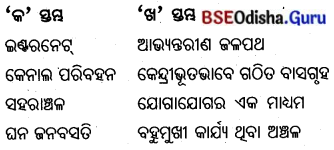
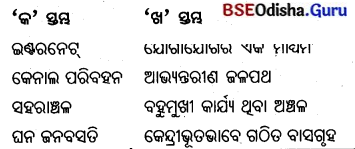
![]()
![]()

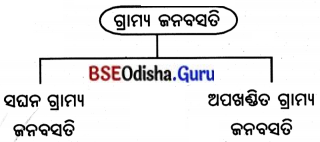
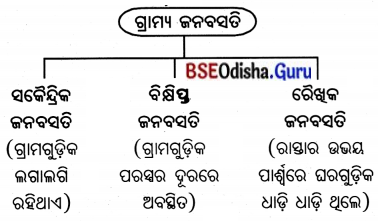
![]()
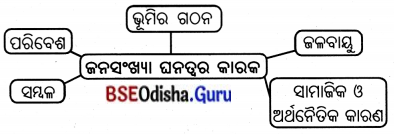

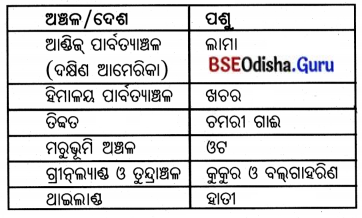
![]()
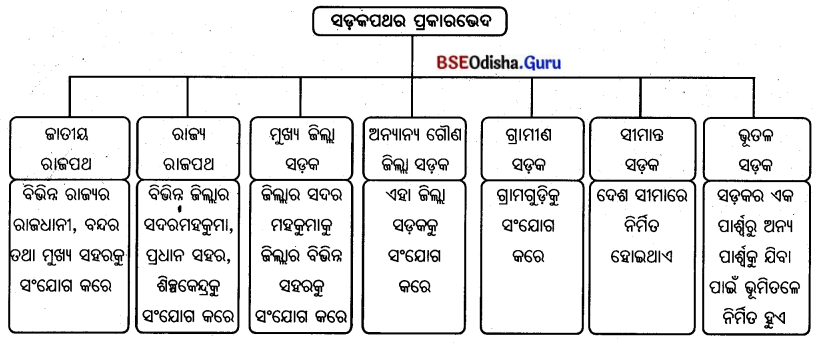
![]()



![]()
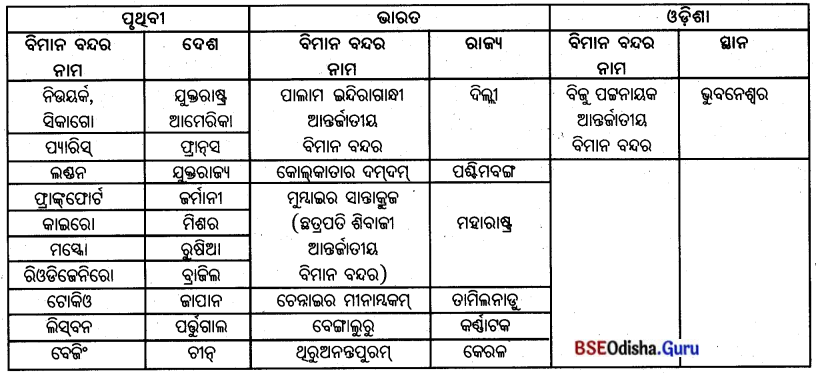
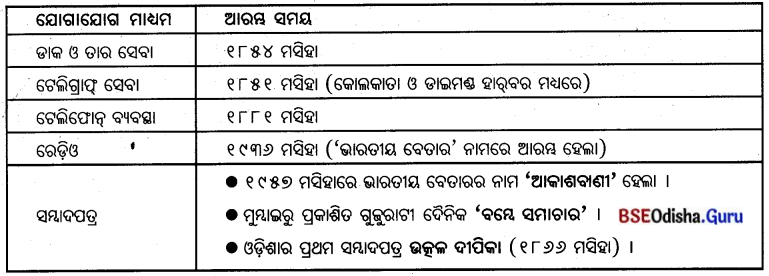
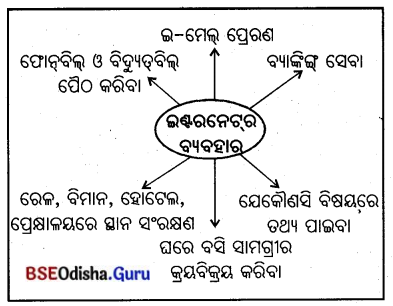
![]()
![]()

